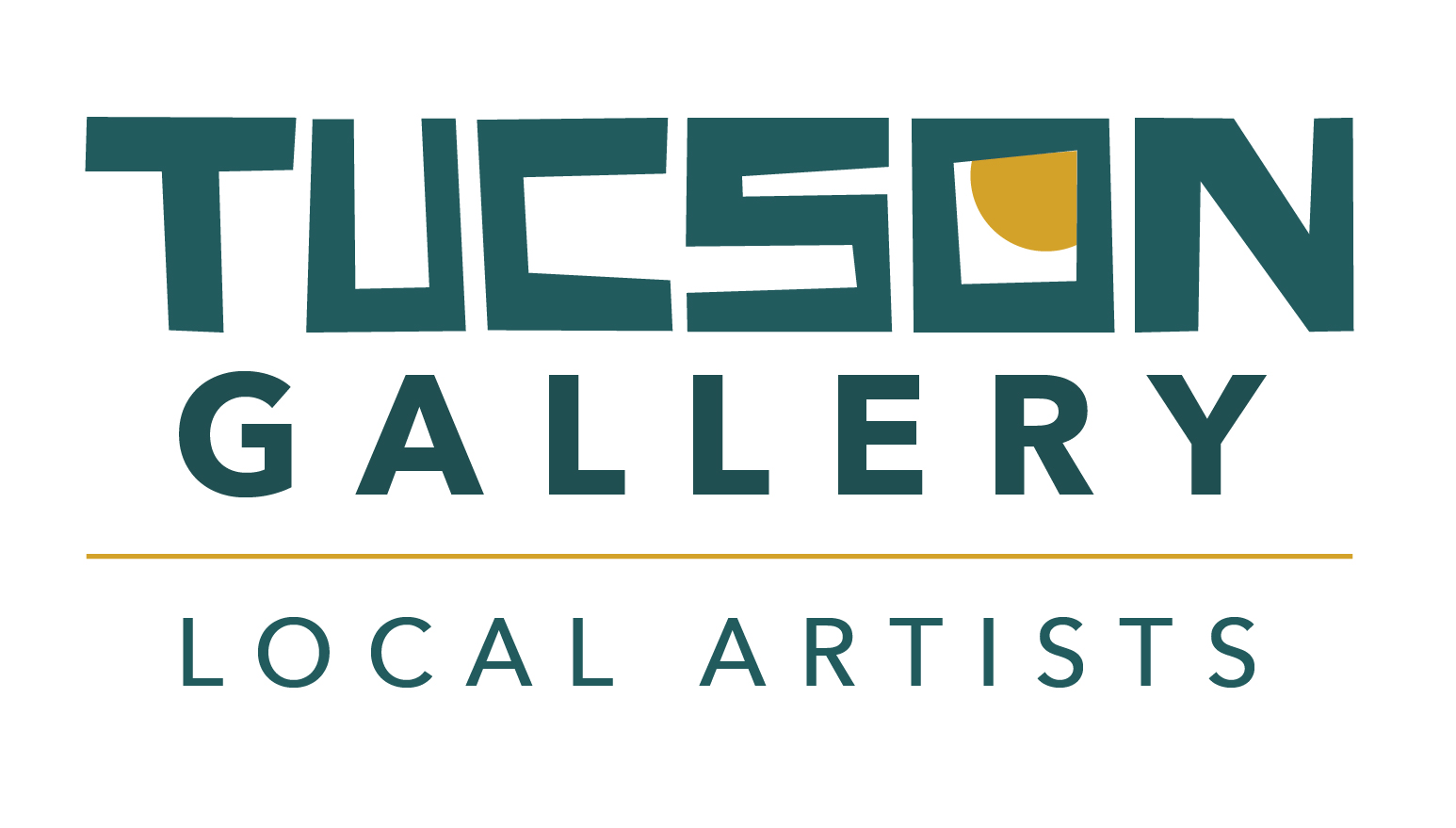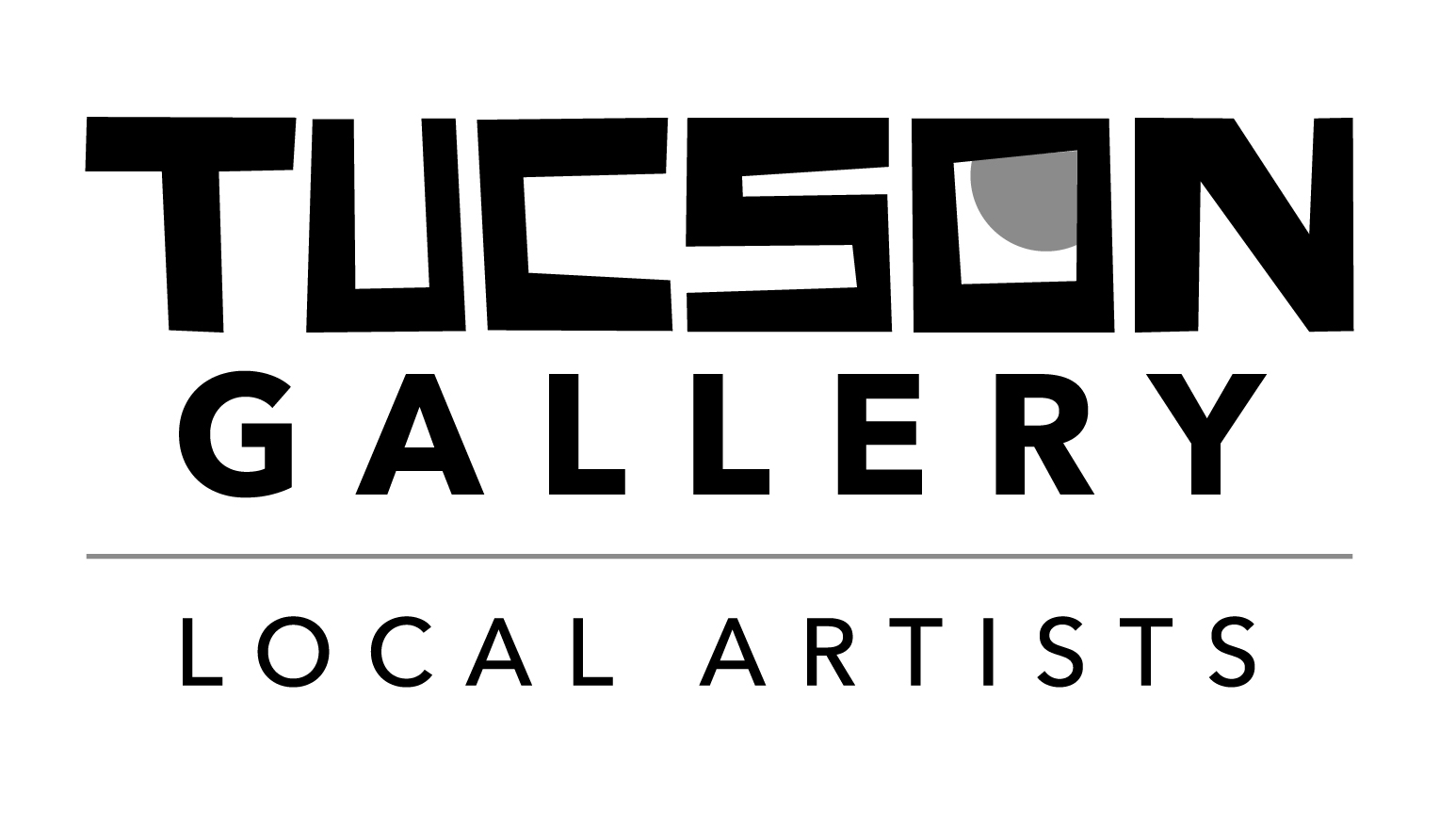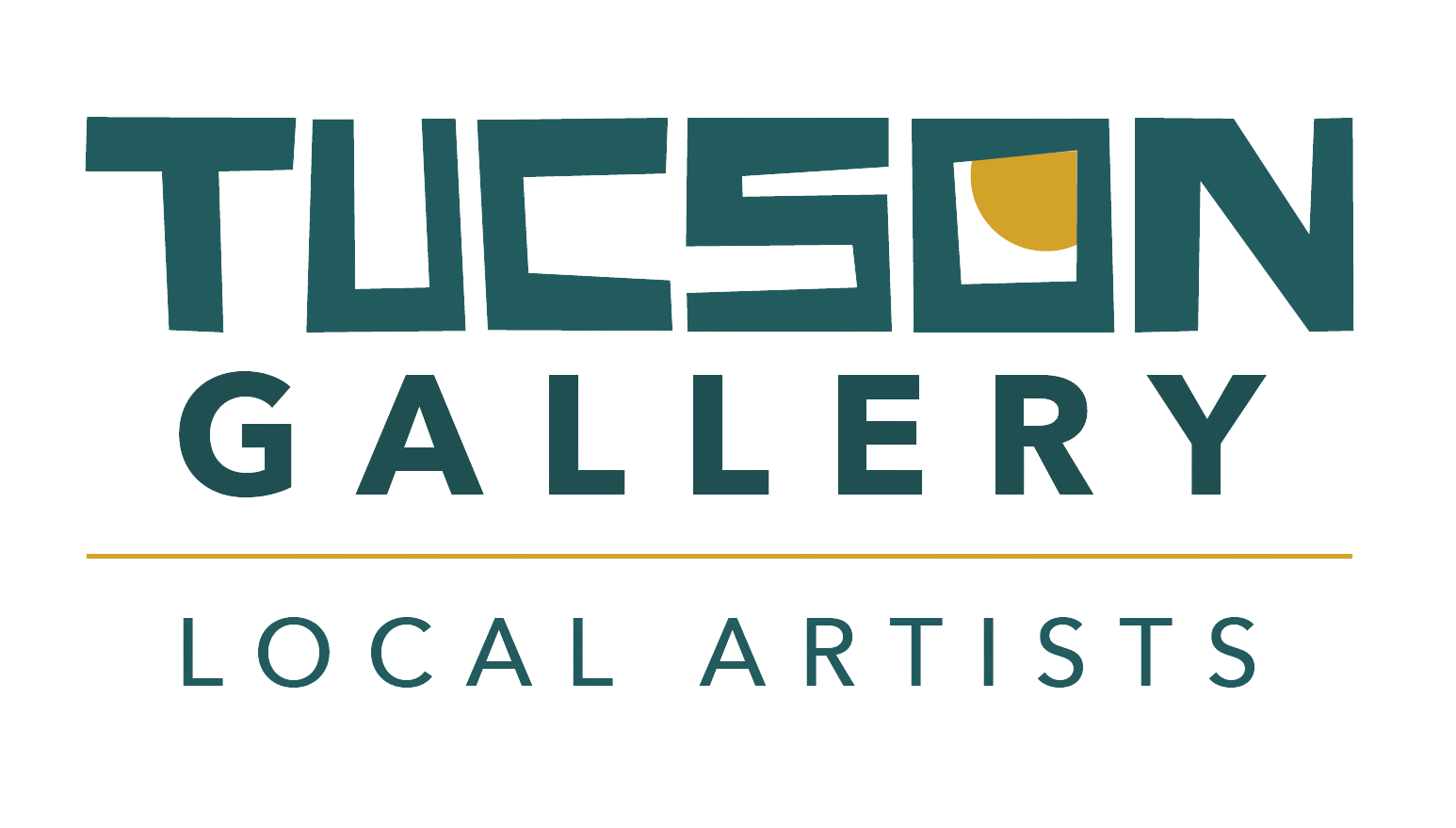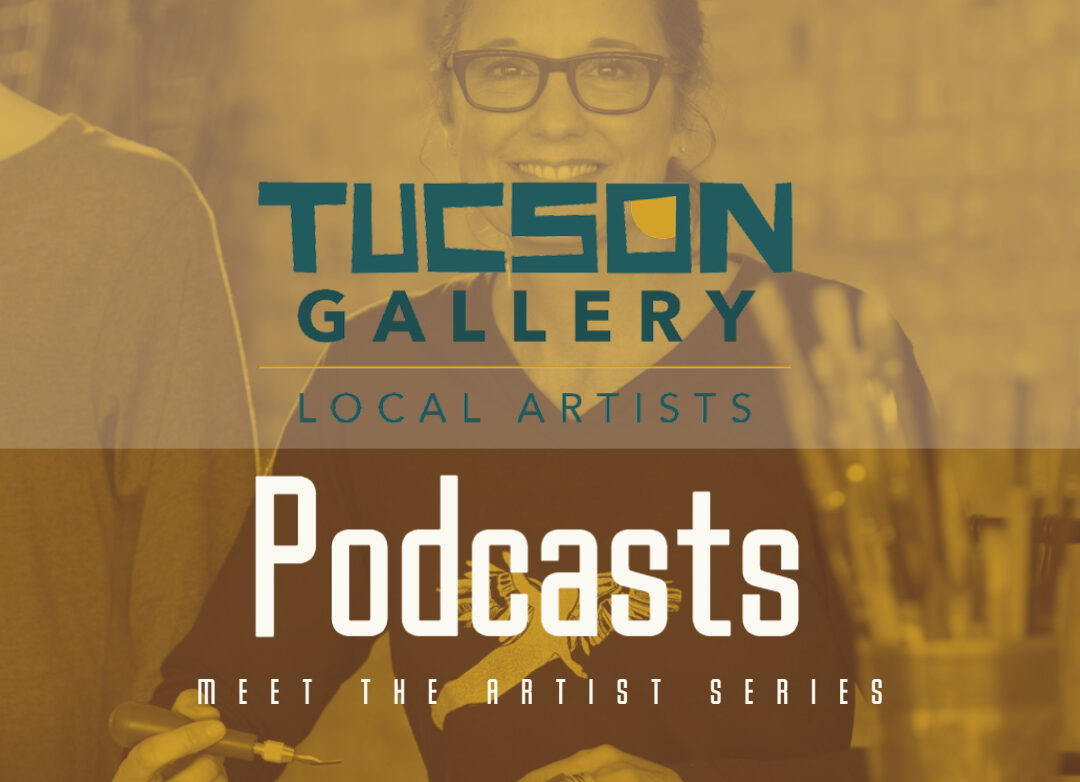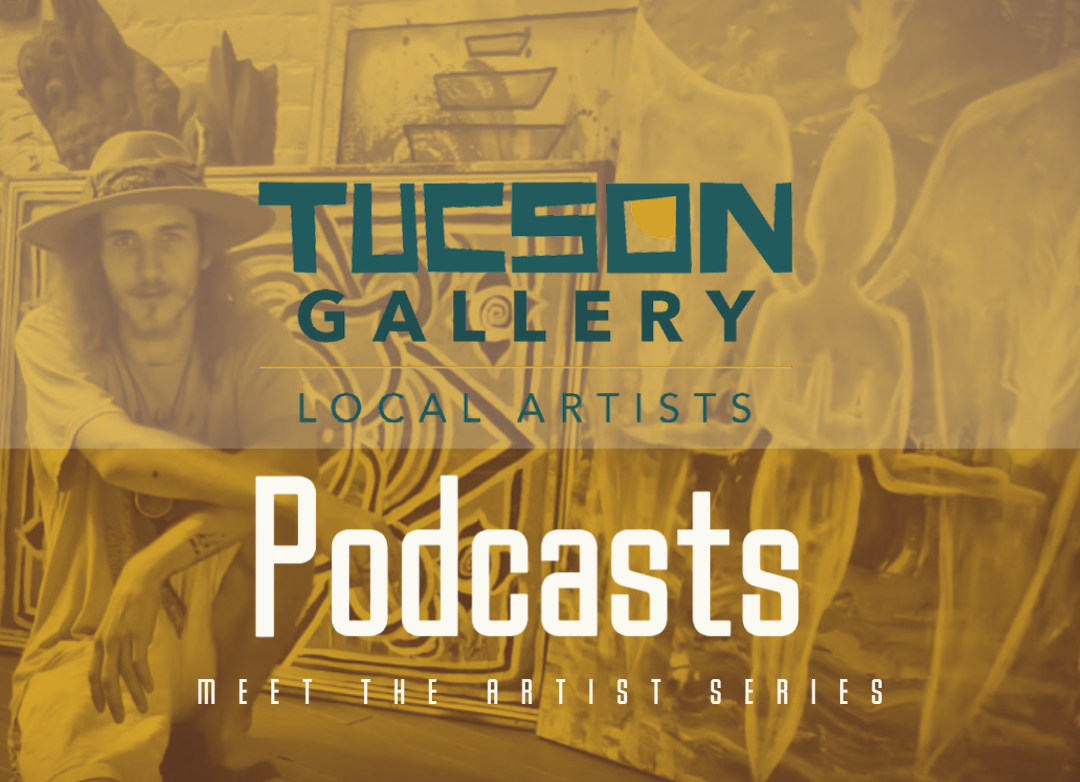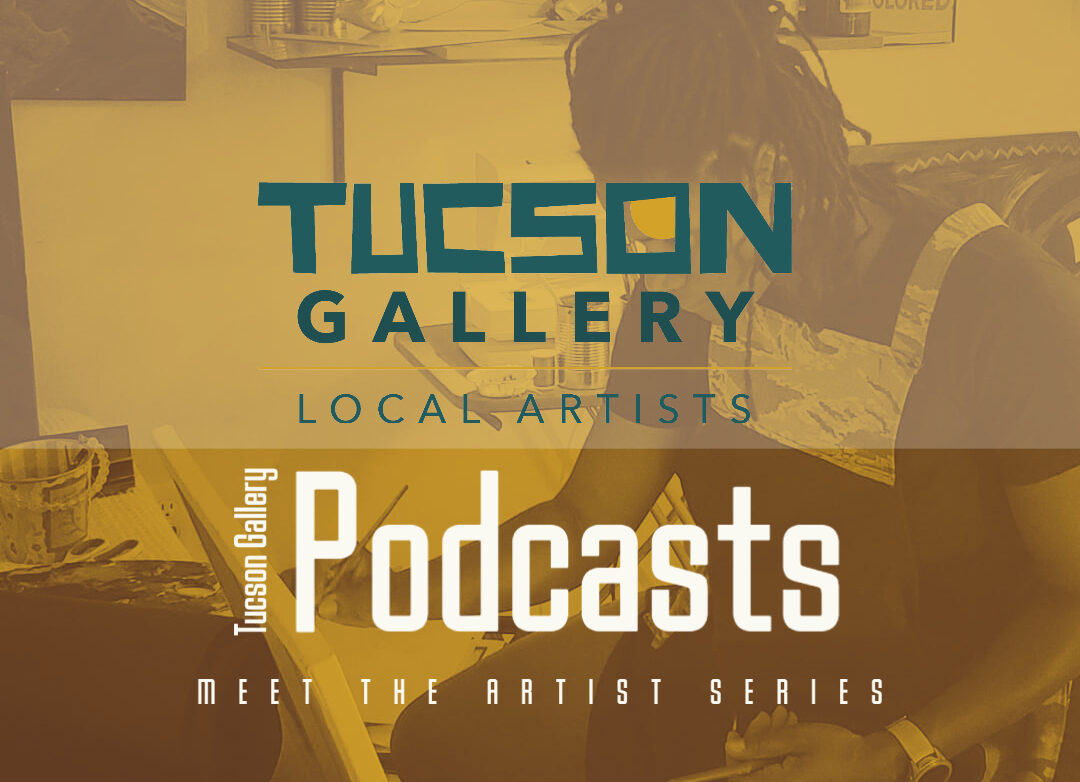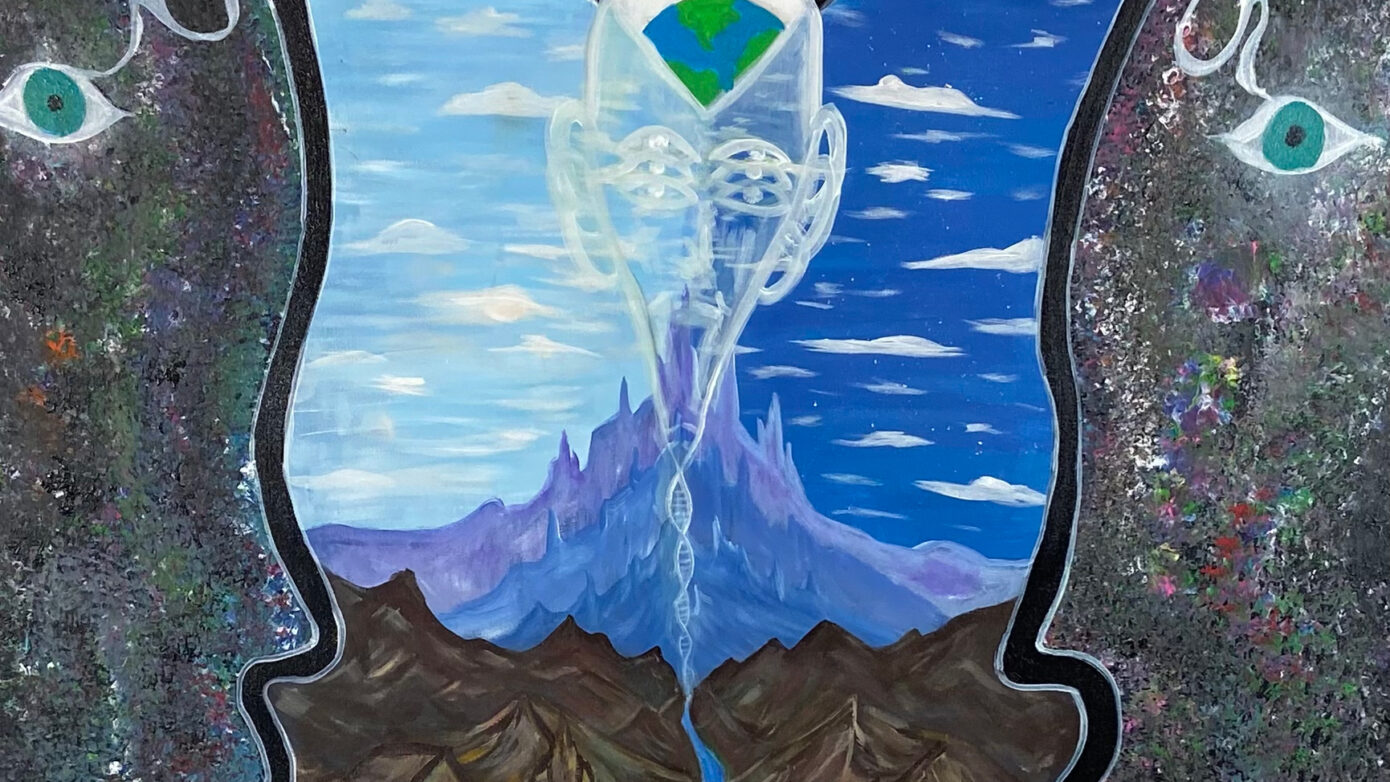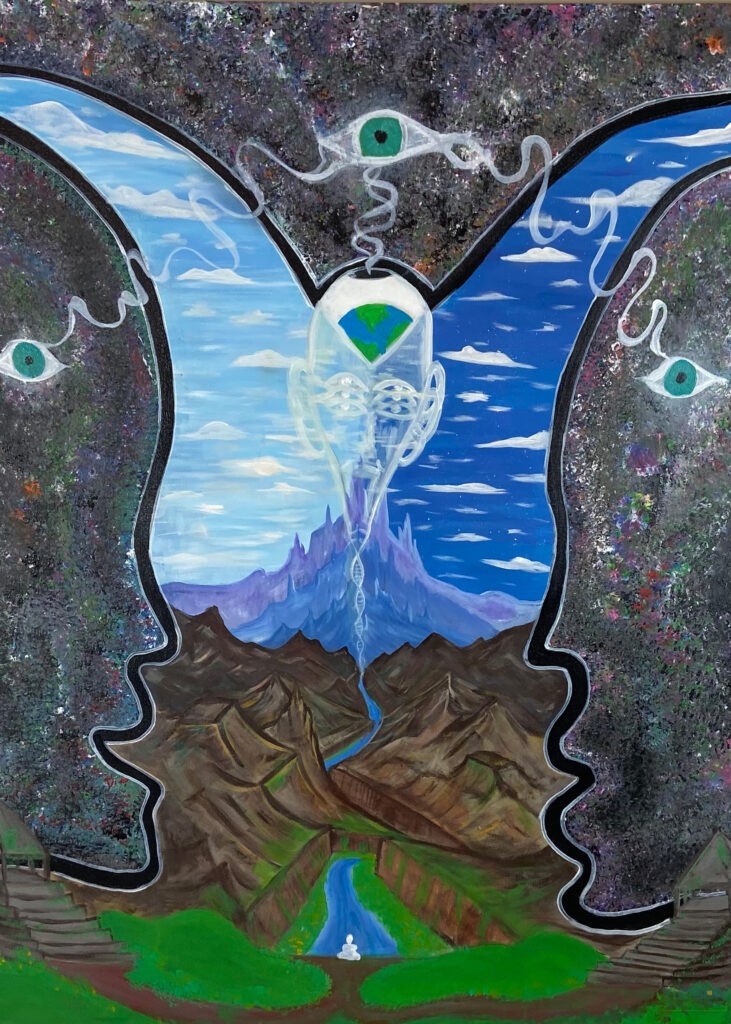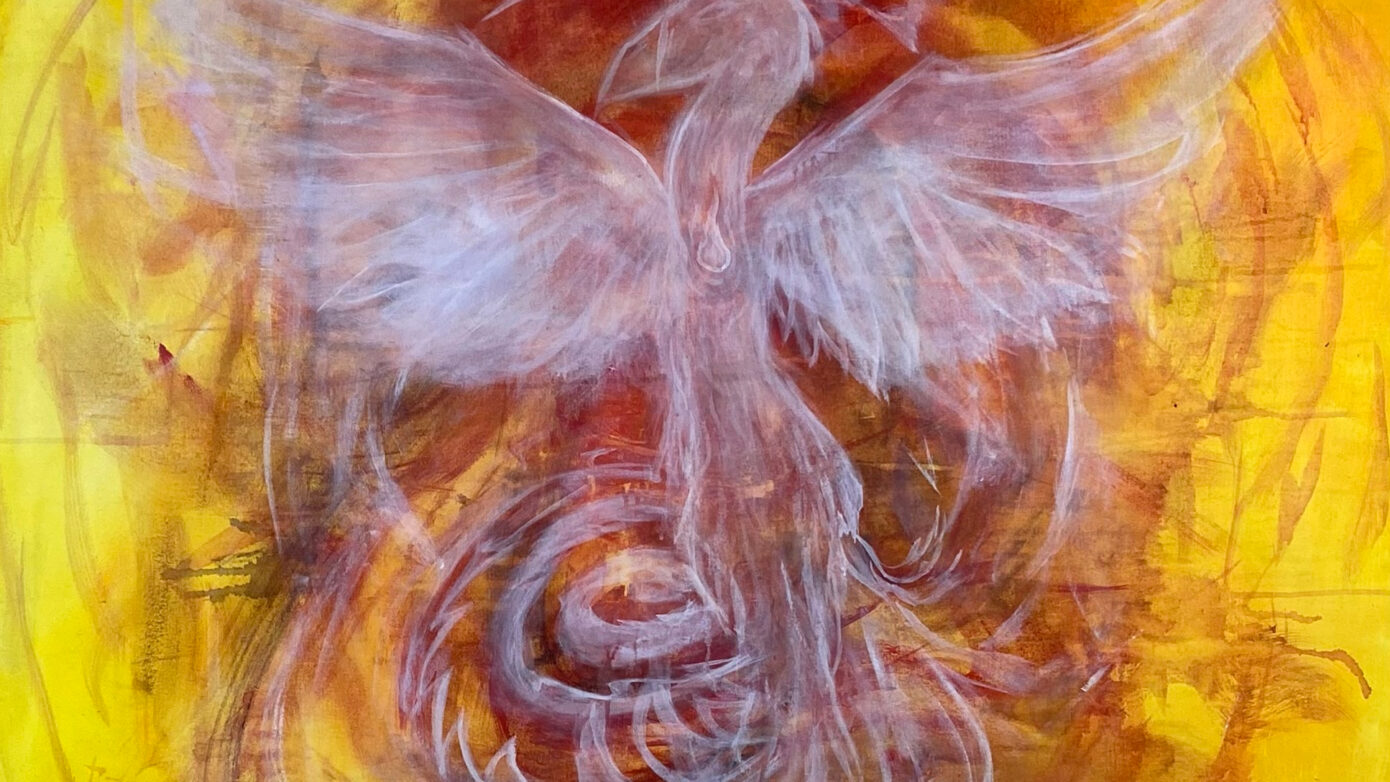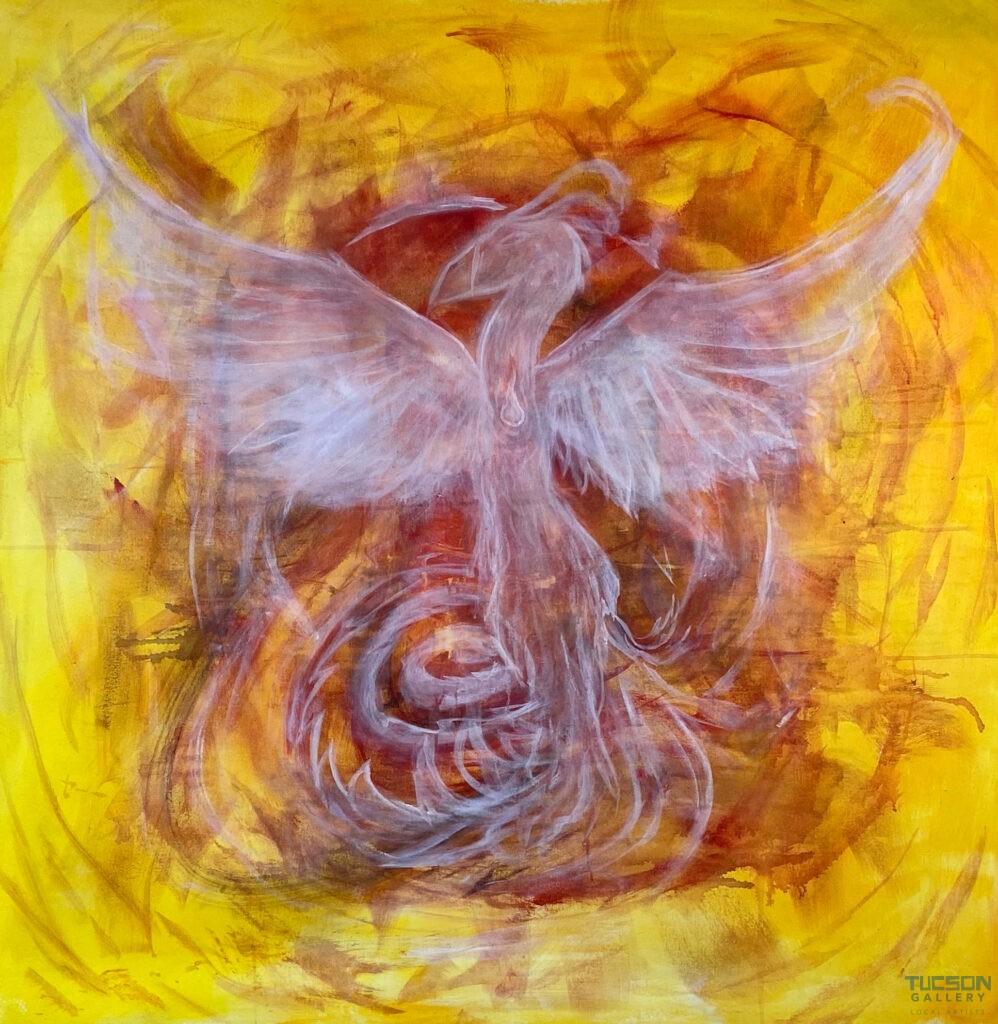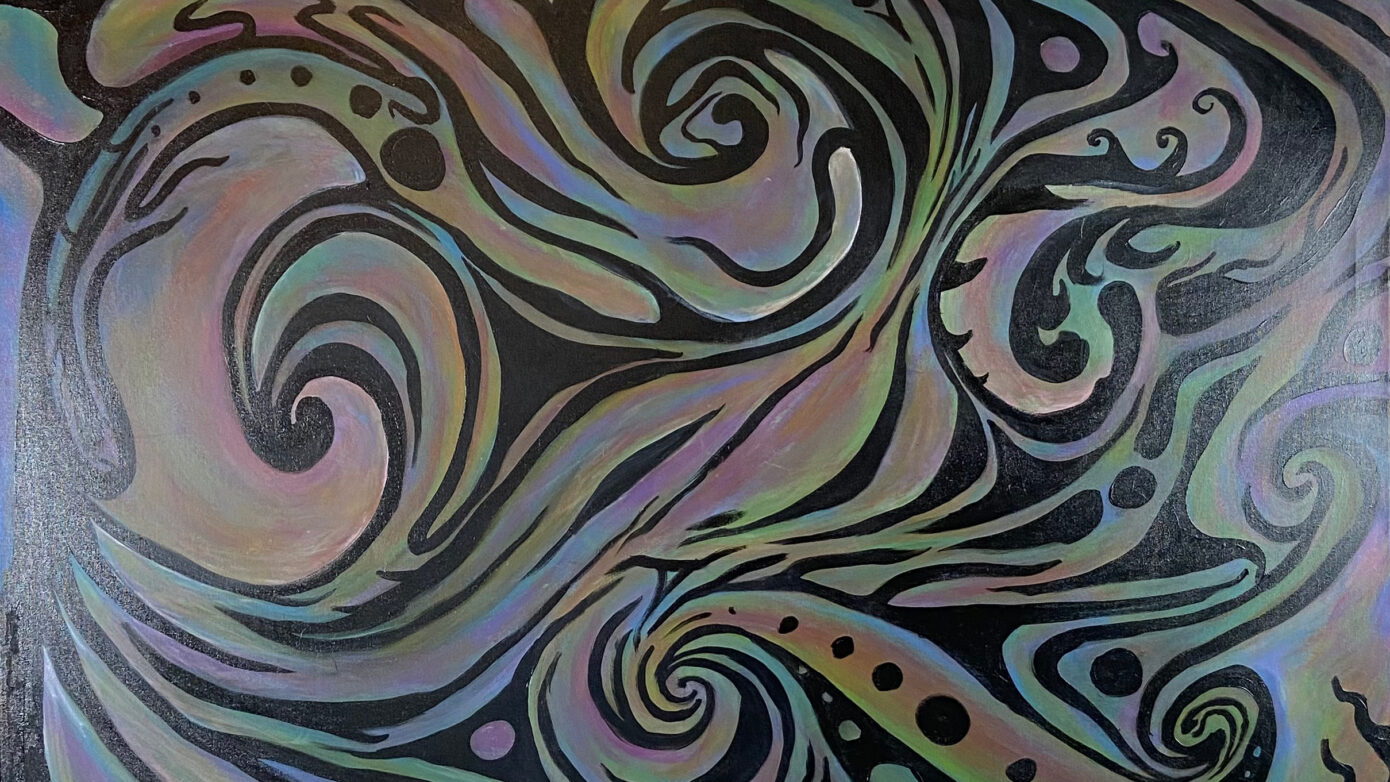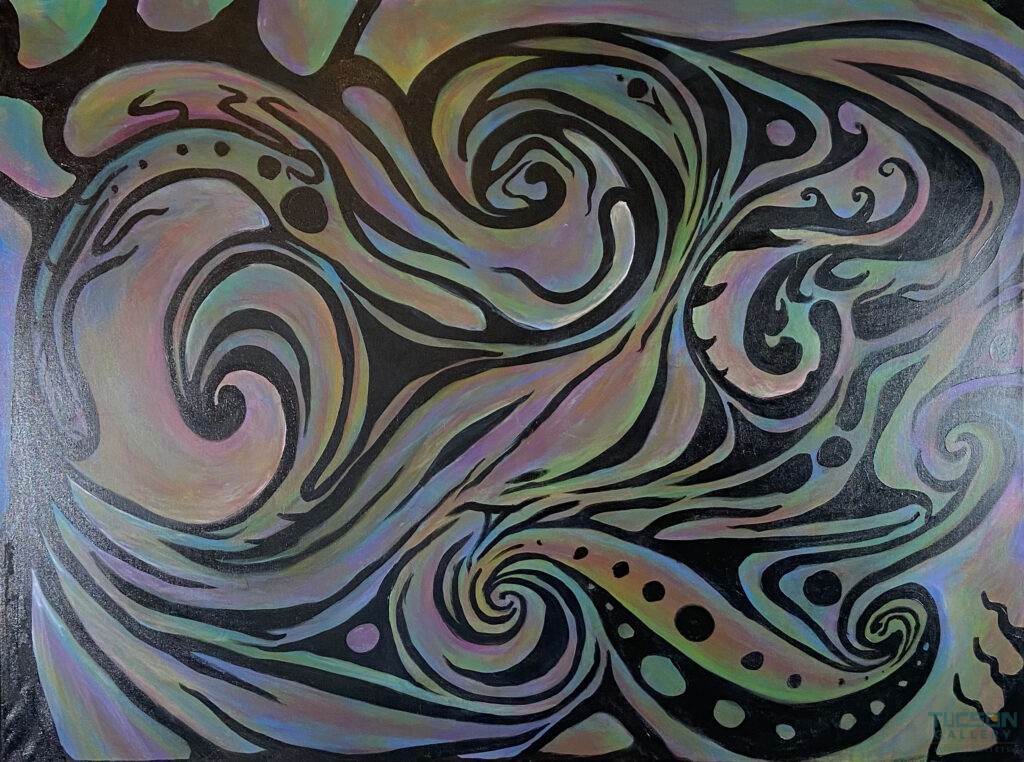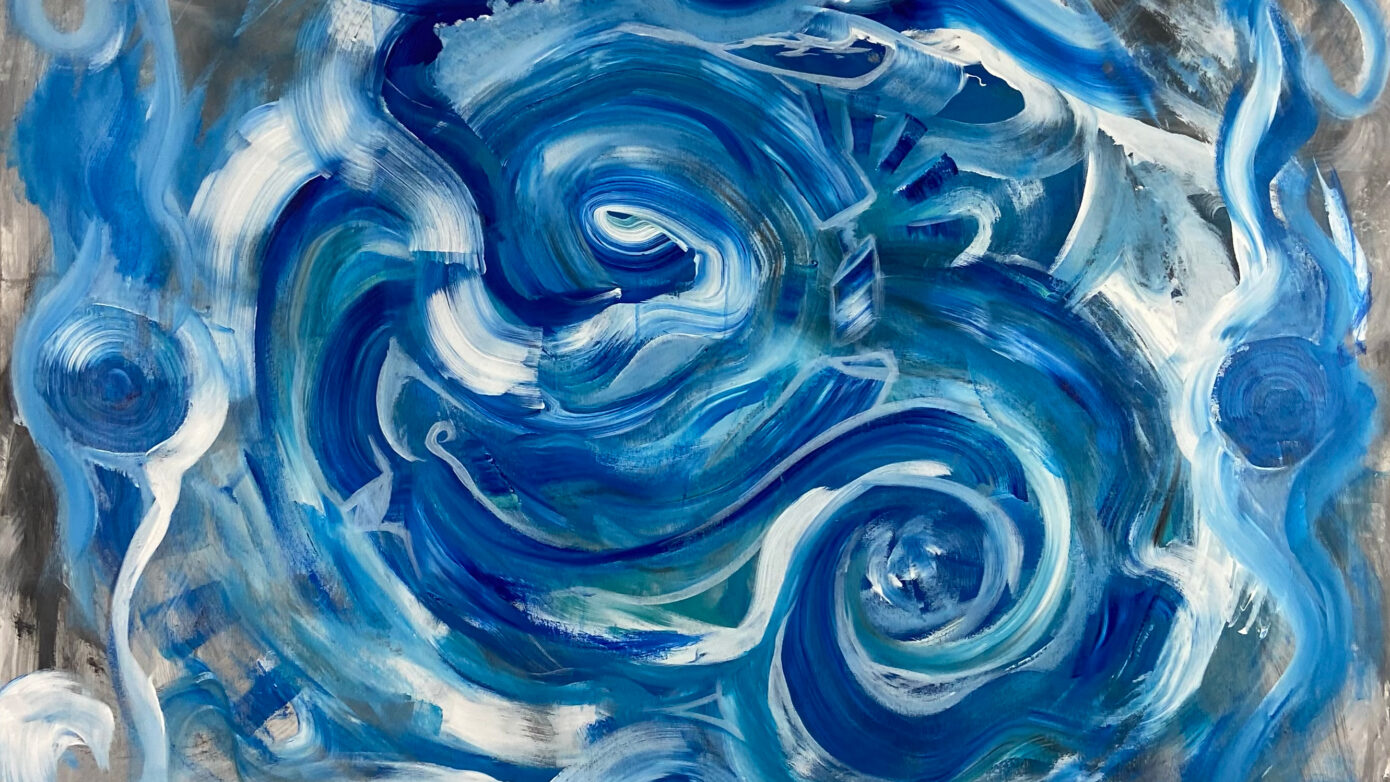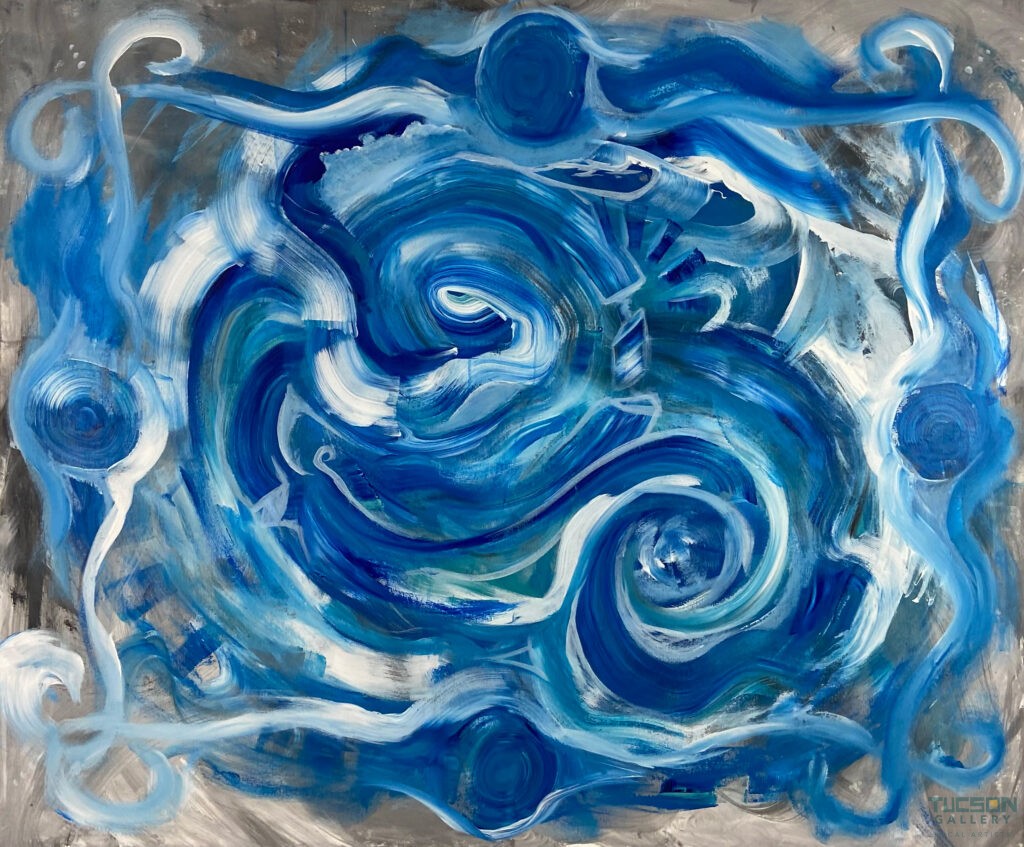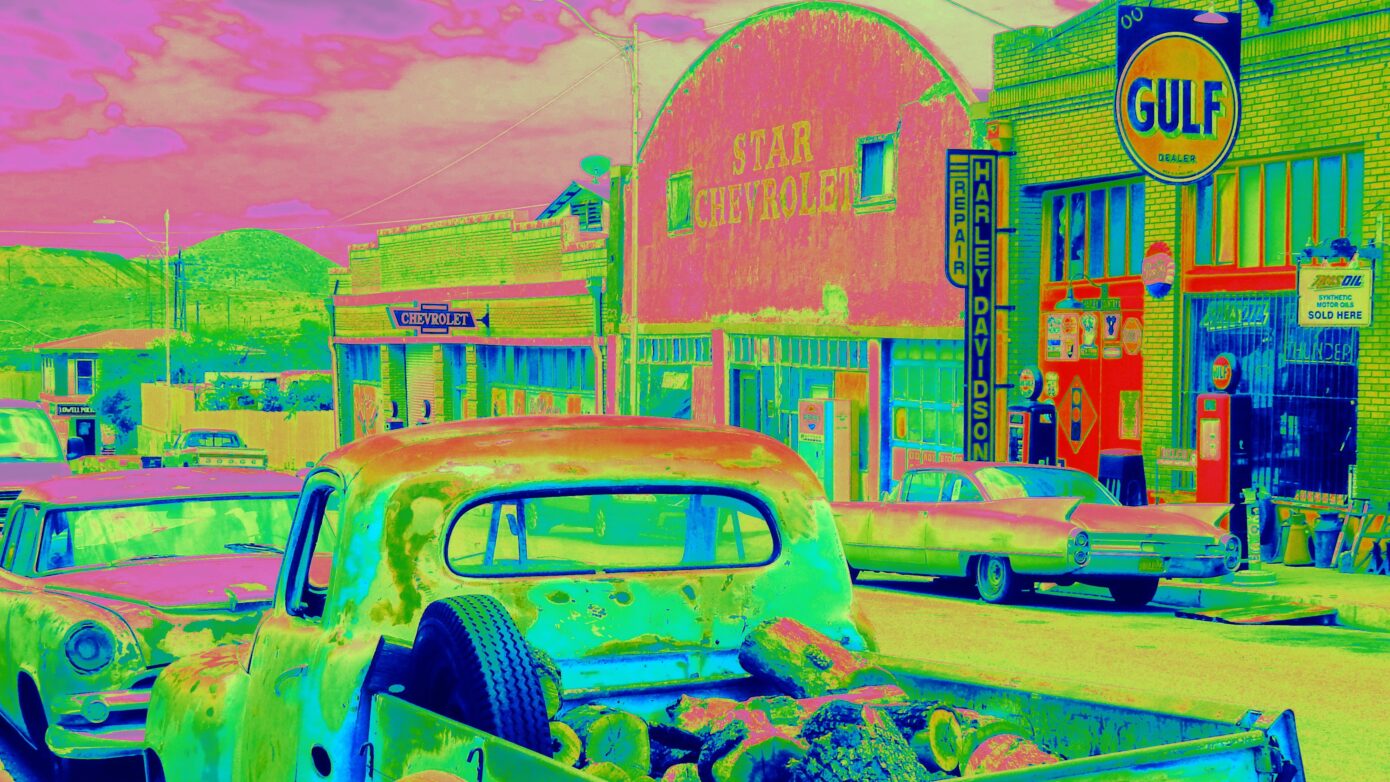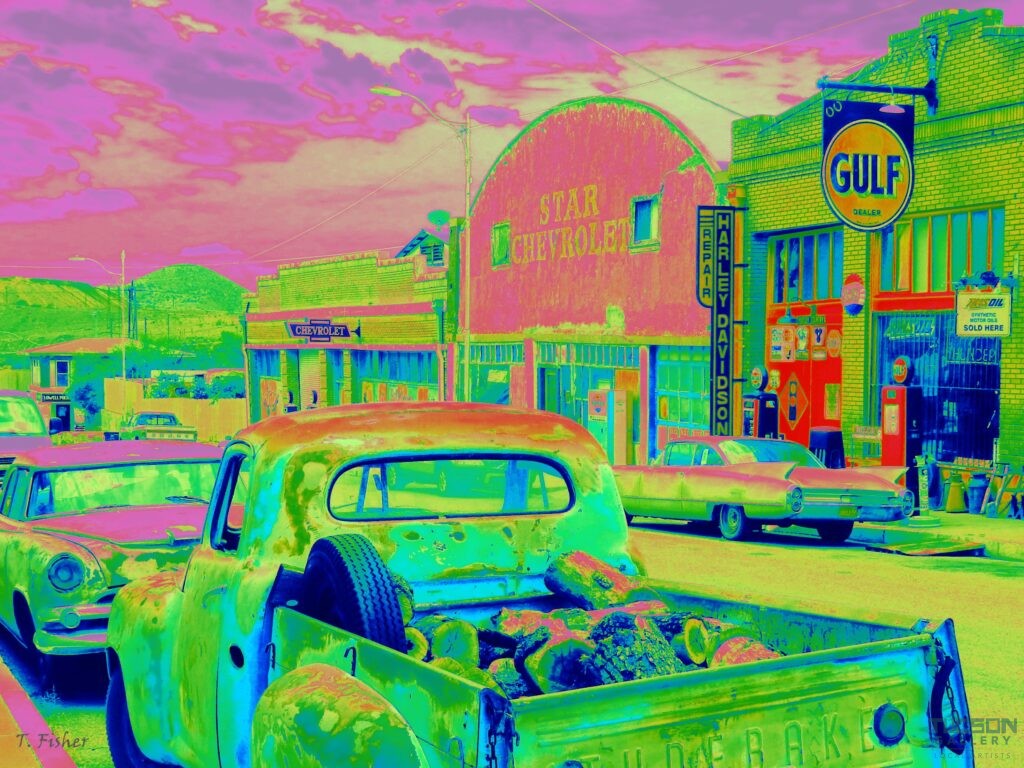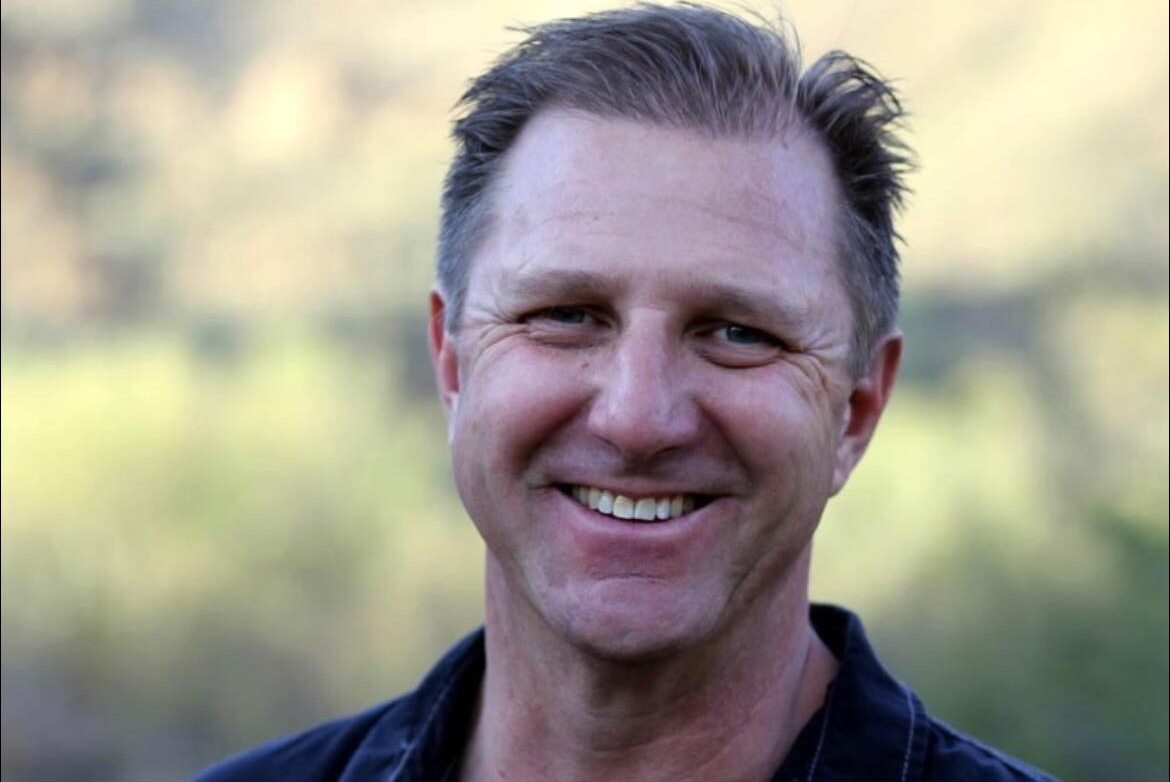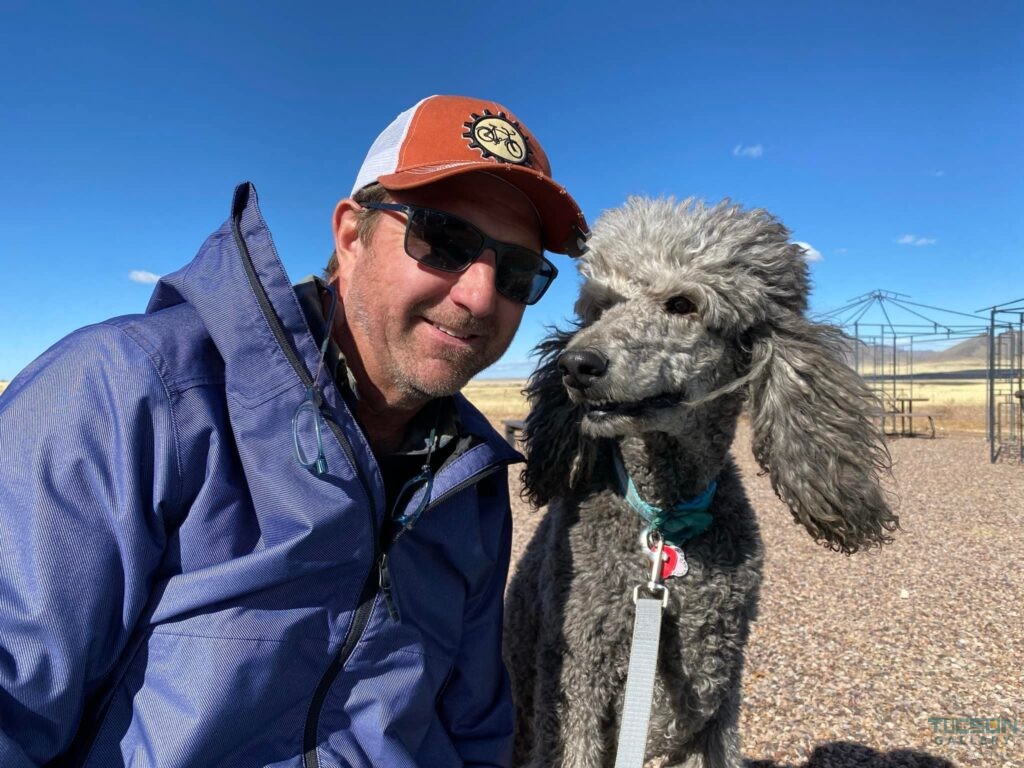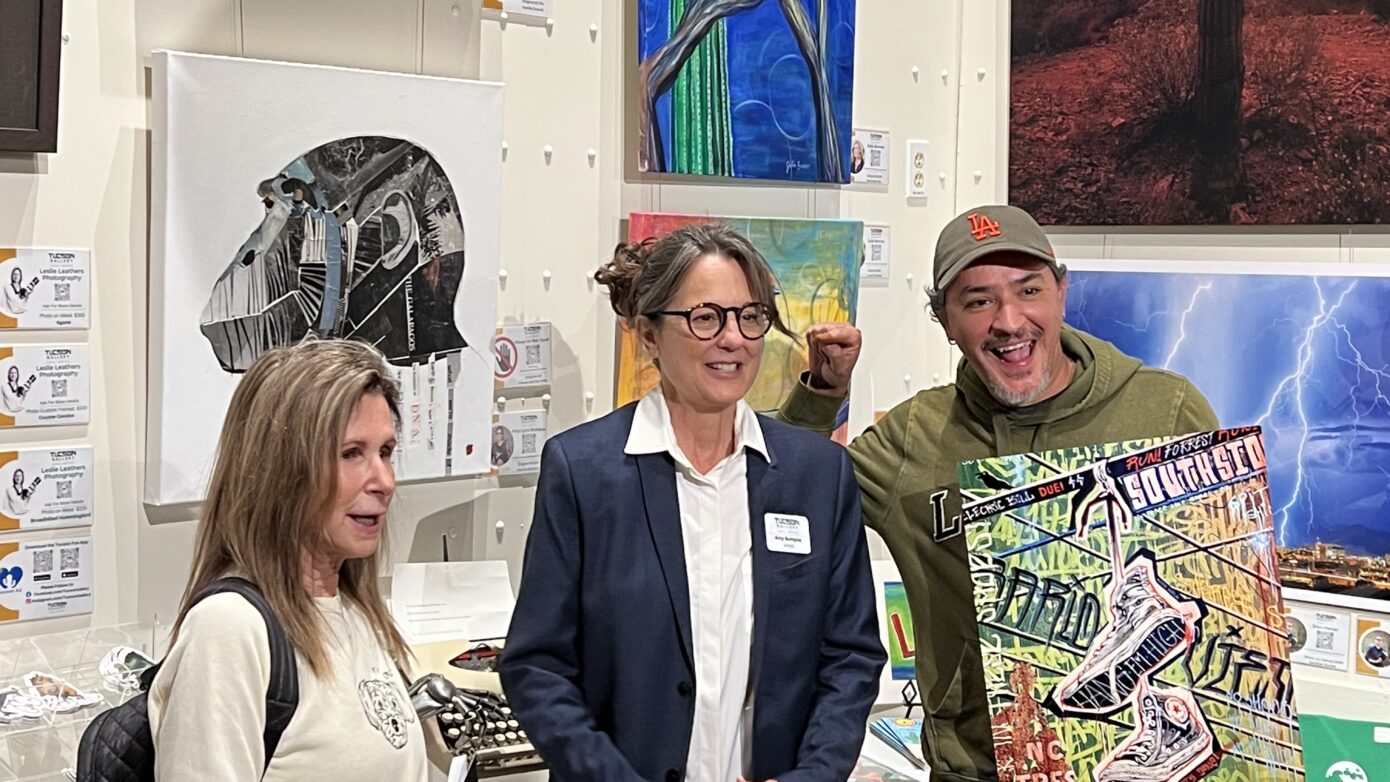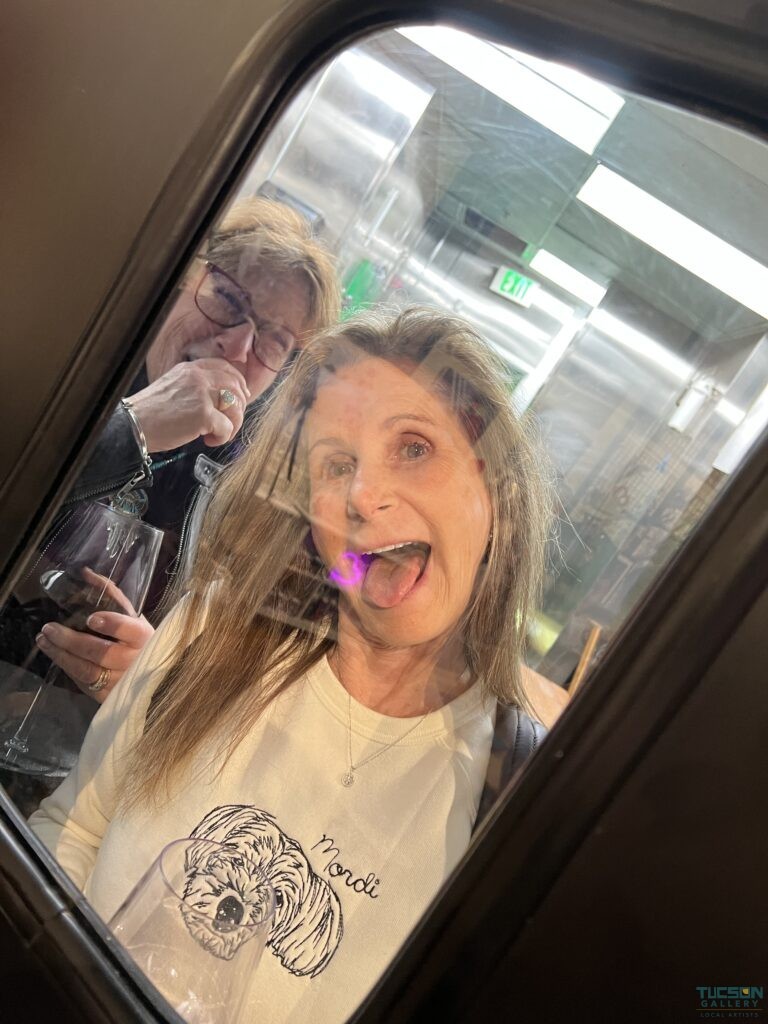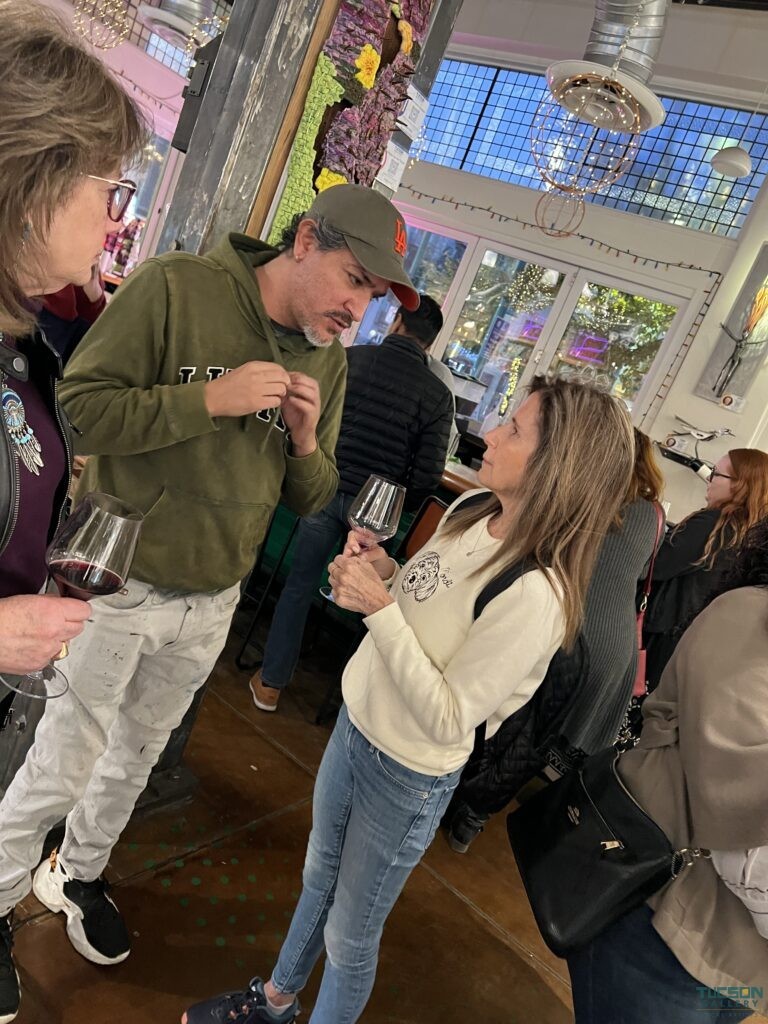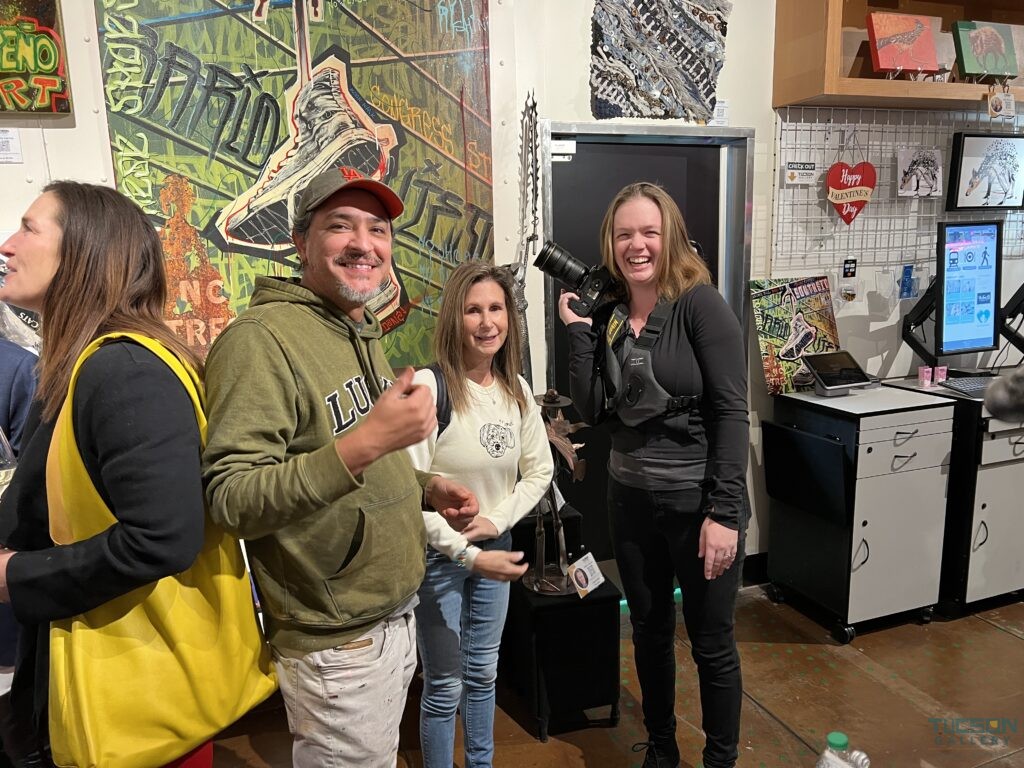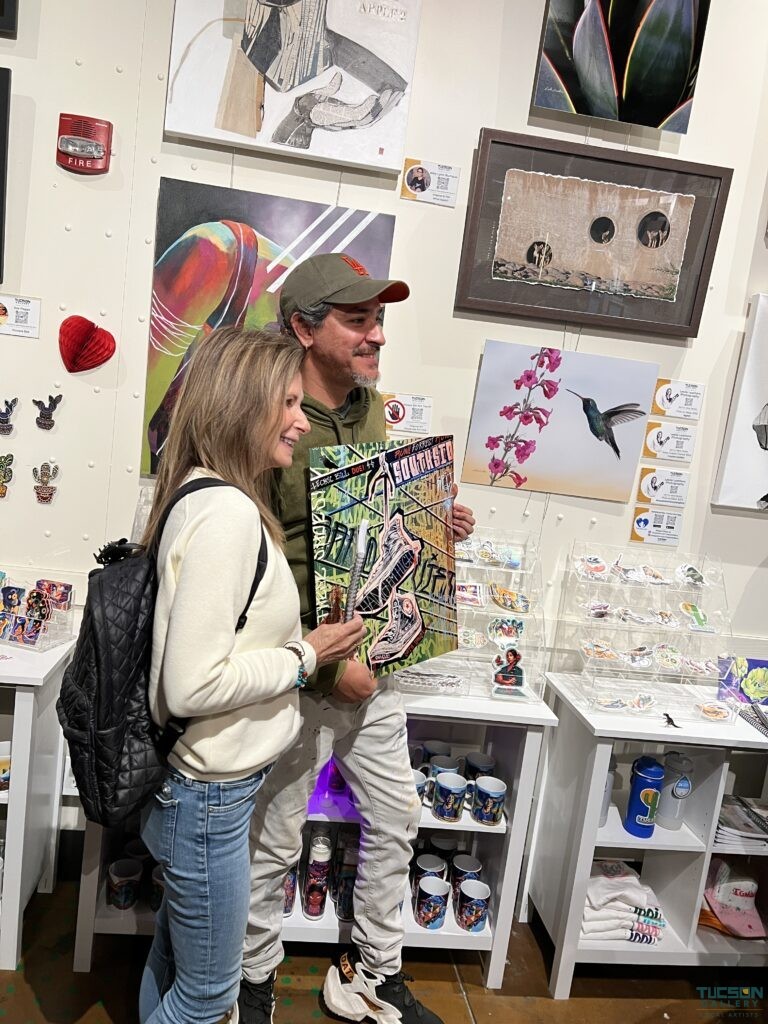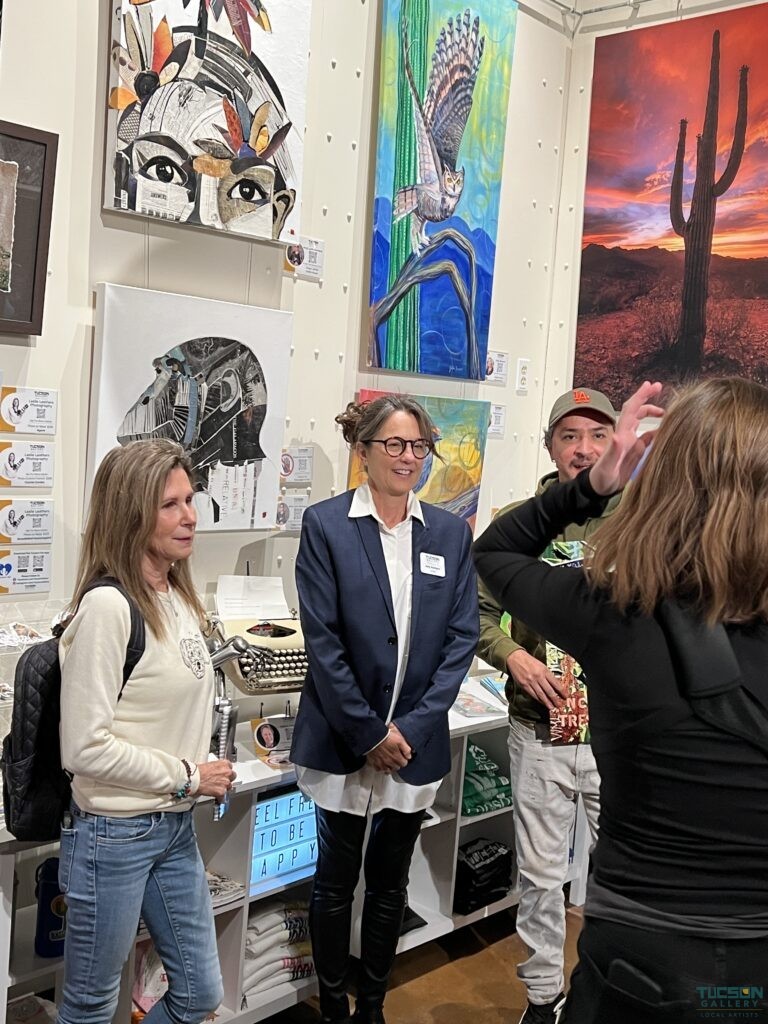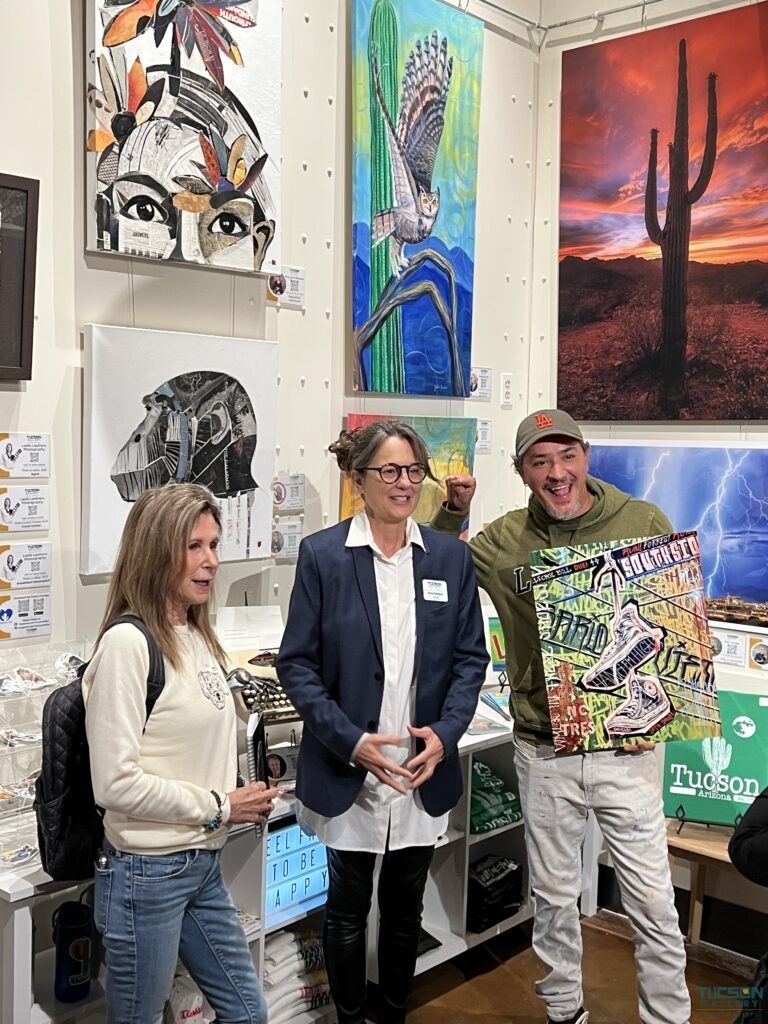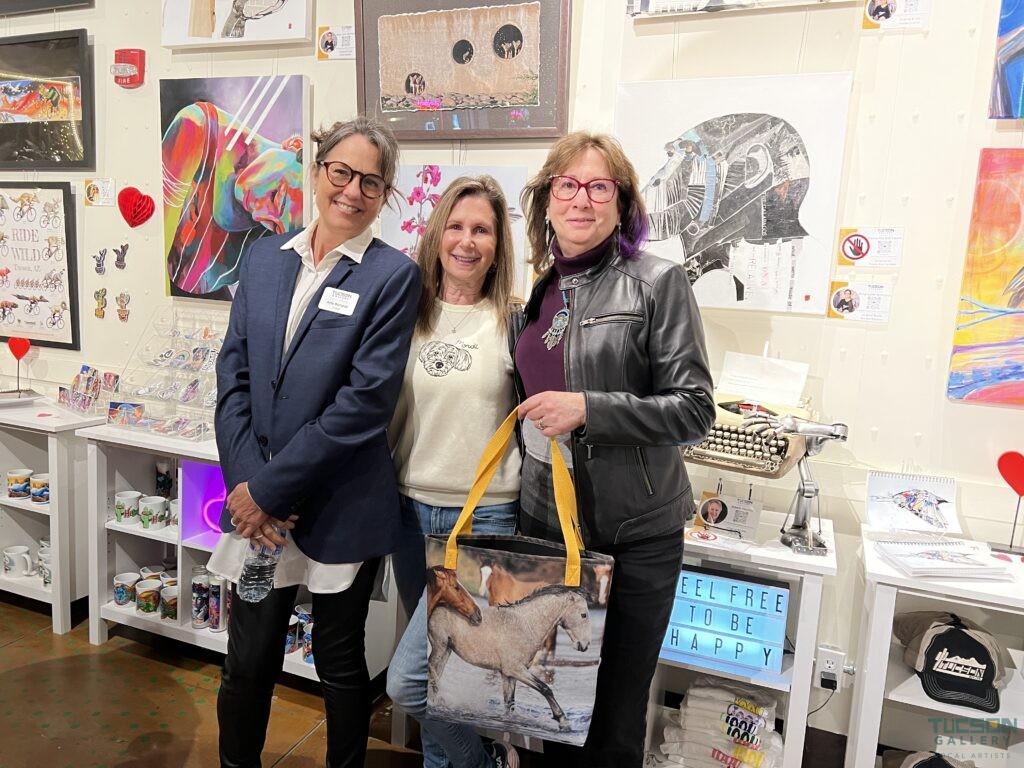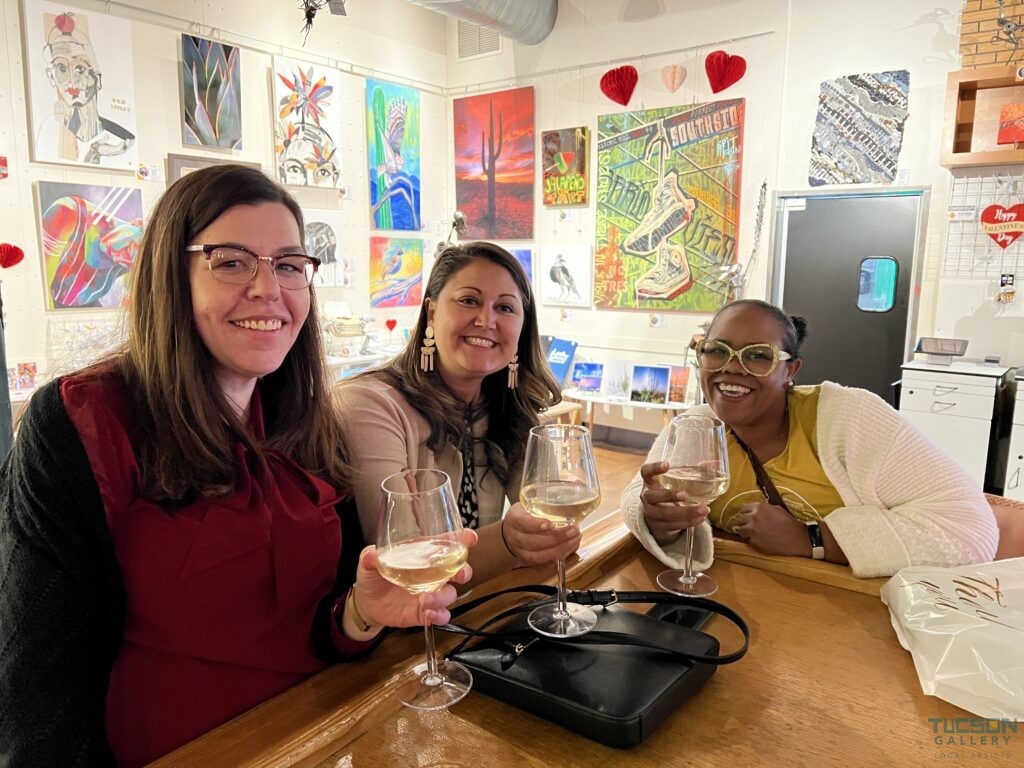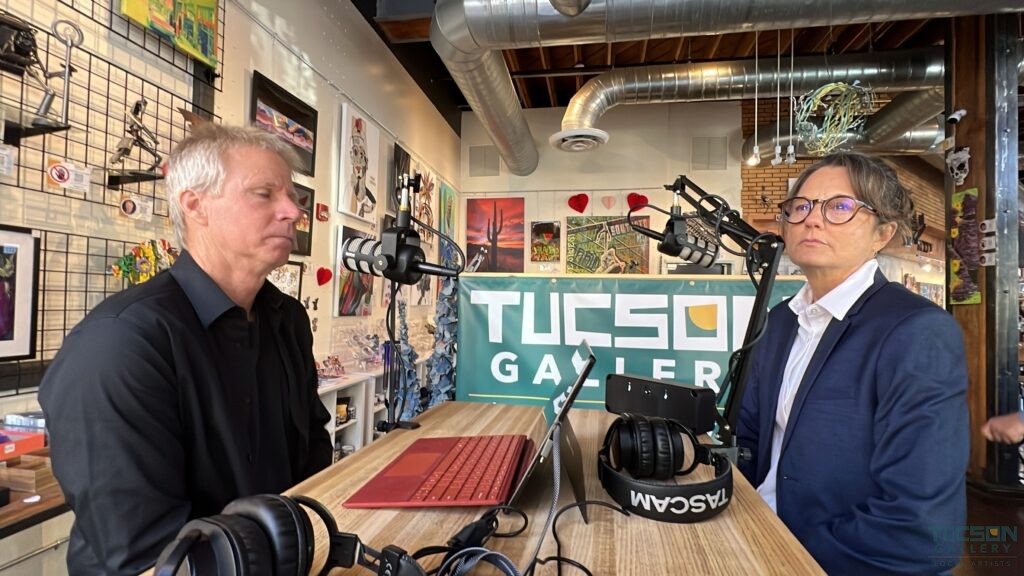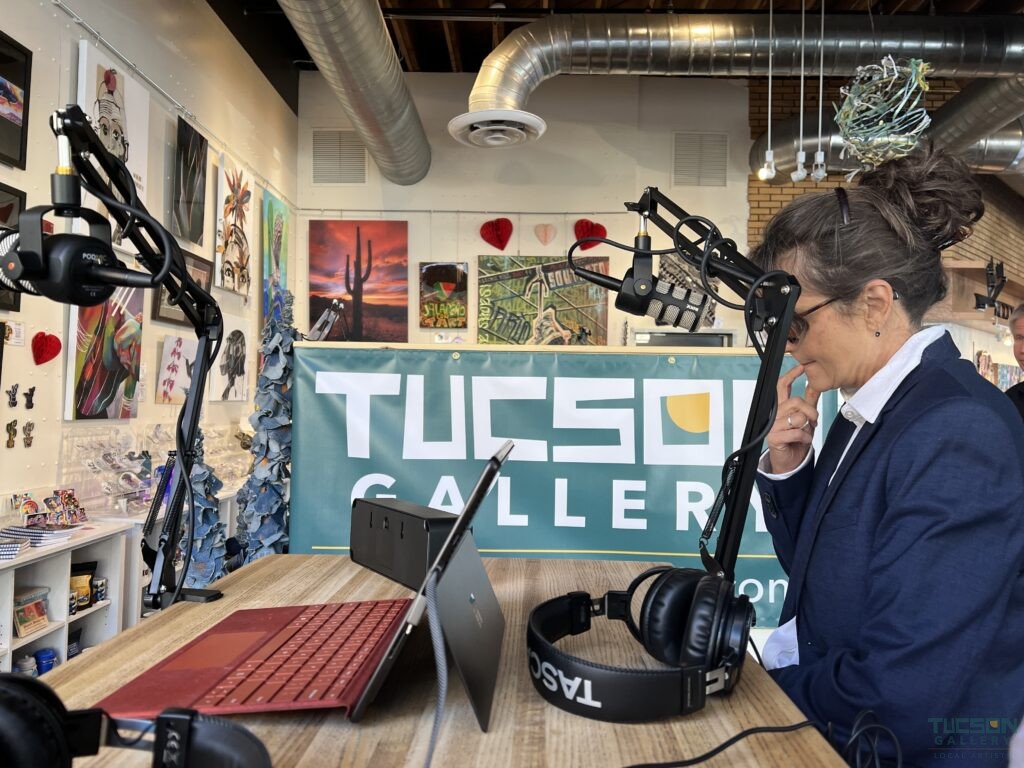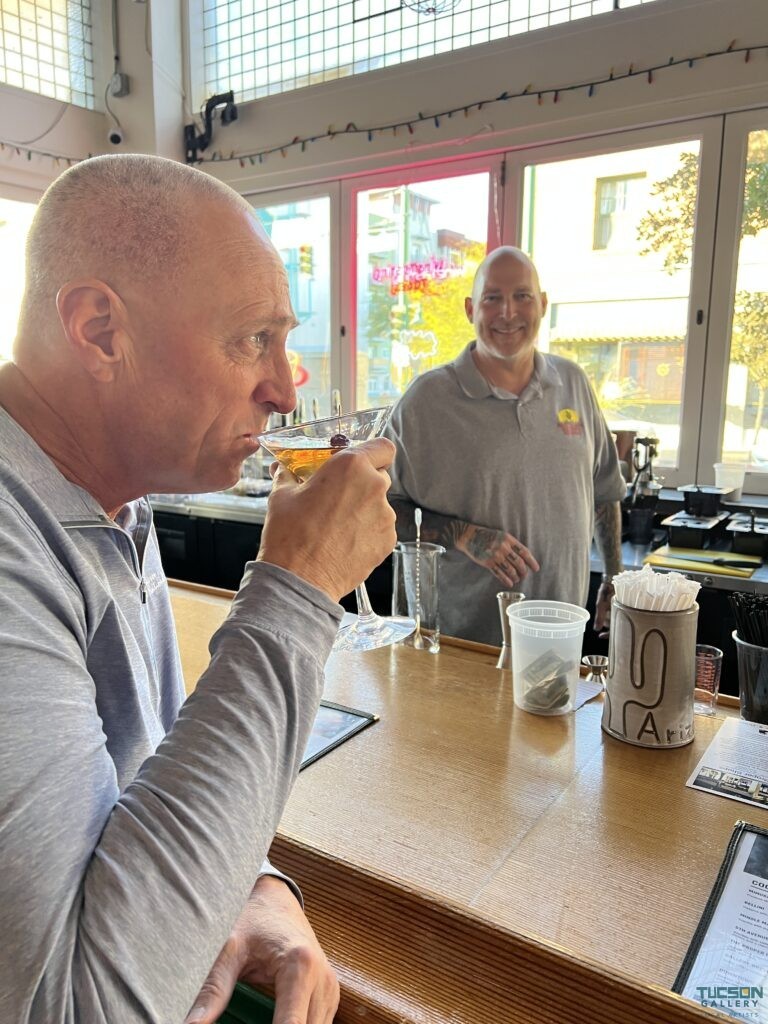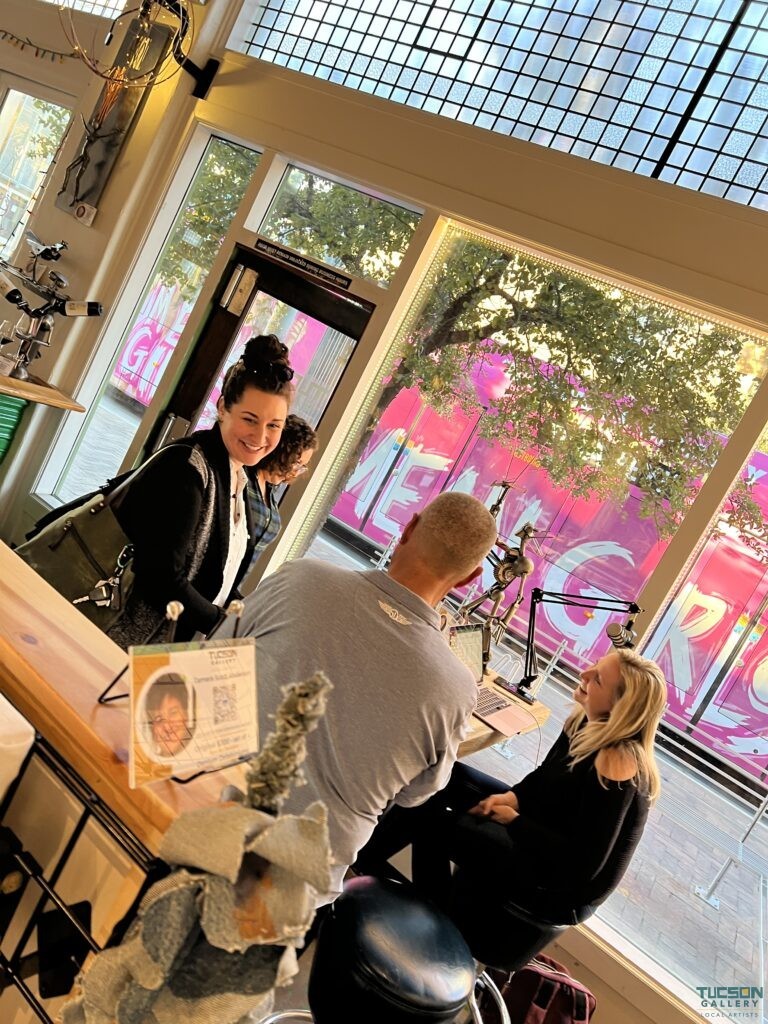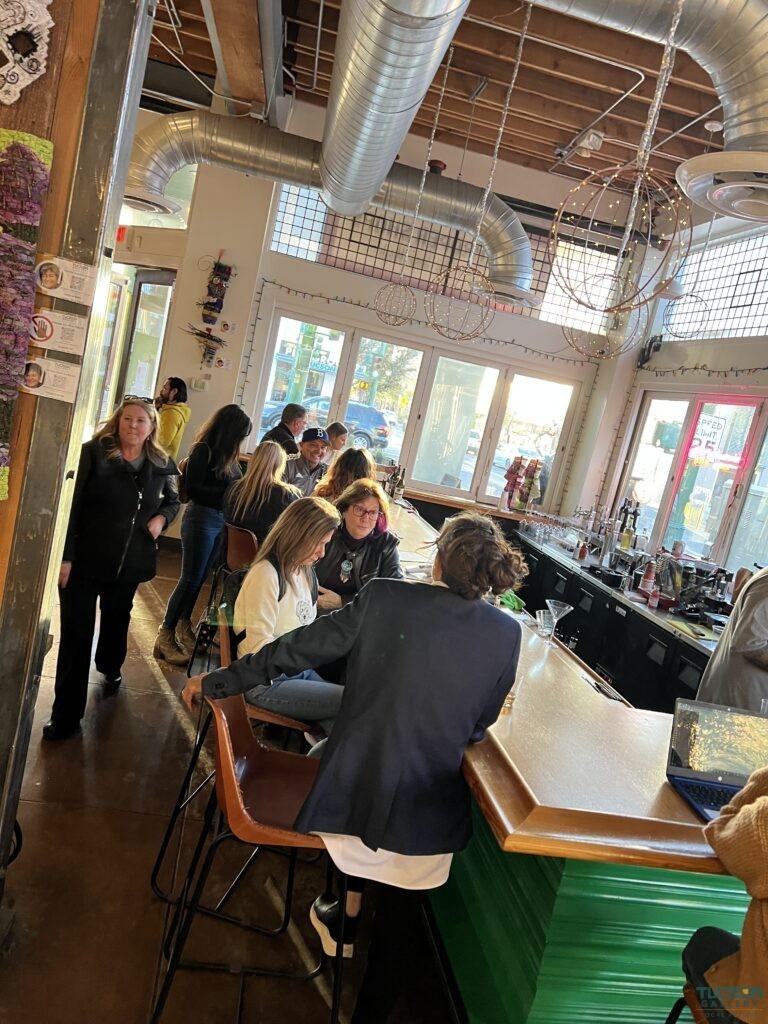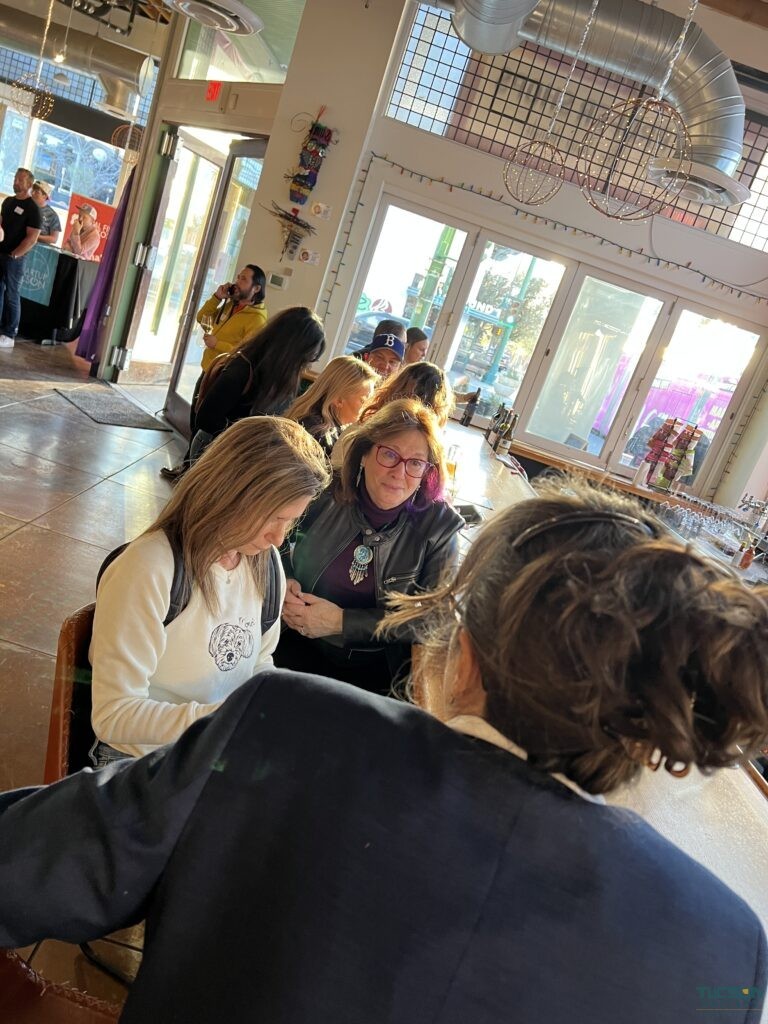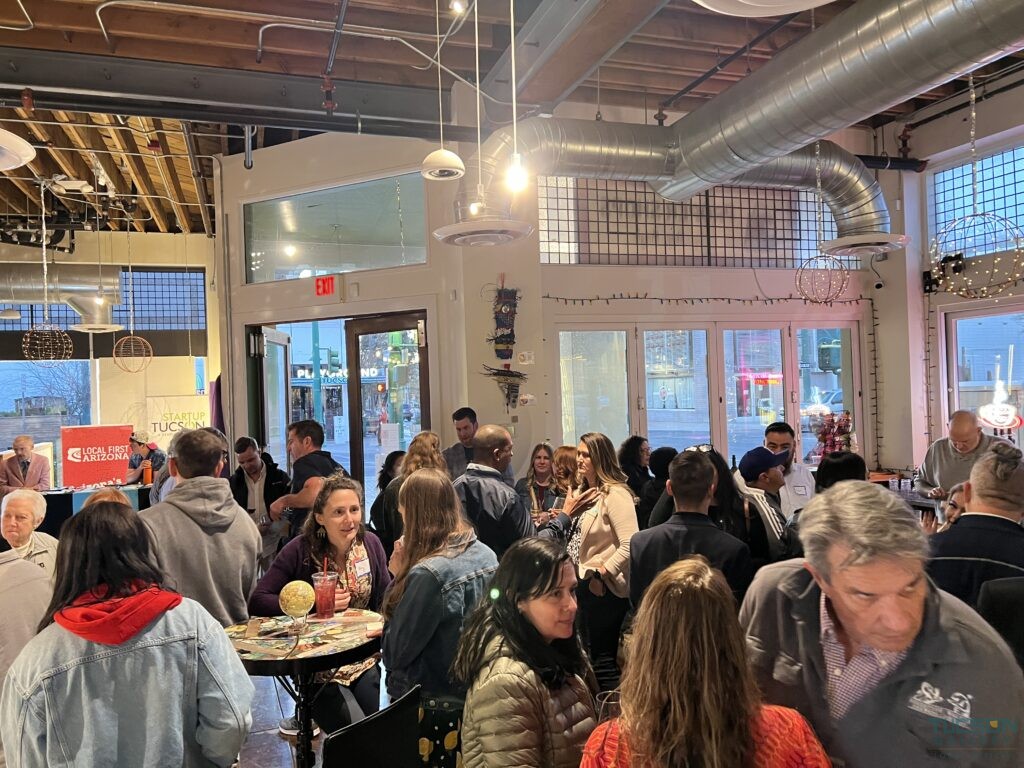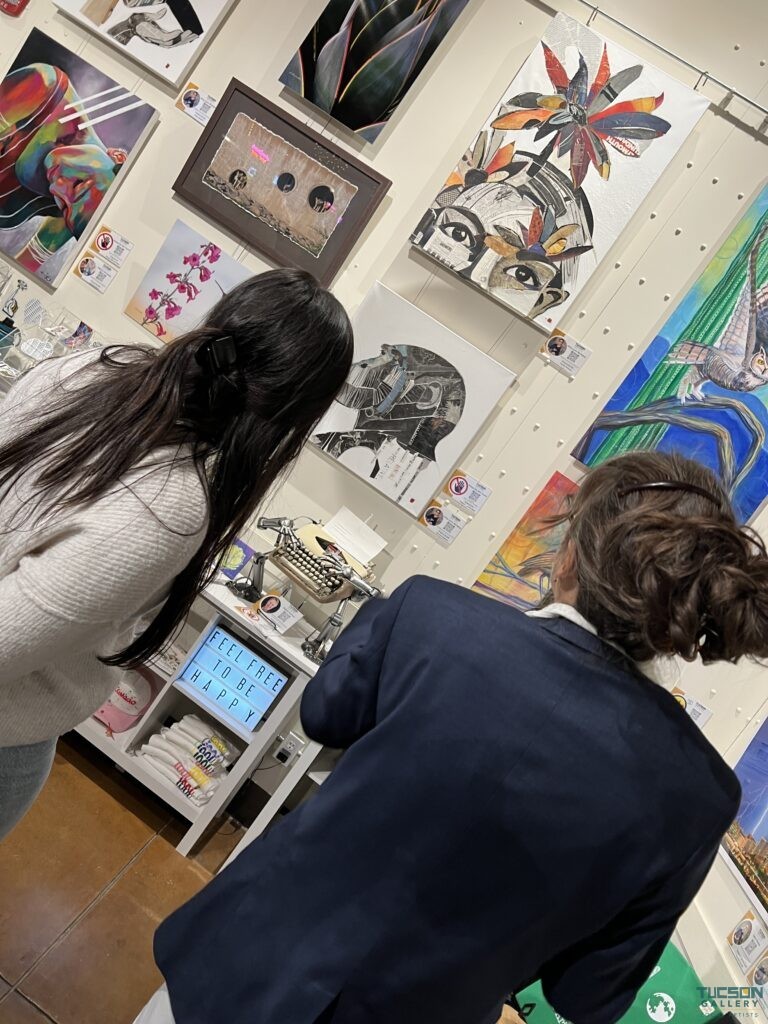Transcript (Unedited)
Tom Heath
Well, here we are, another rendition of Meet the Artists. We’re inside of the Tucson Gallery on Congress and Fifth Avenue, 300 East Congress, across from the Hotel Congress. And part of this retail collective called the Proper Shops. And the Tucson Gallery’s role is to give artists an opportunity to showcase their work as well as help the world understand how amazing our artists are here in Tucson. So not only do we have the gallery of the website Tucsongallery.com, and then every week we bring a different artist in to talk about their process. They hang out here at the bar inside of the Proper Shops from five to seven. And we start all of these Meet the Artist events off with a recording of a podcast. So if you hear some noise in the background, those are just some raucous art fans going nuts. But that’s okay.
Amy Lynn Bumpus
At the bar.
Tom Heath
At the bar. We’re in the gallery and I think you’d be excited about the gallery.
Amy Lynn Bumpus
All went the same.
Tom Heath
We are joined today by the Amy Bumpus, fairly recently to Tucson. How long has it been since you moved to Tucson?
Amy Lynn Bumpus
Just on three years.
Tom Heath
Three years. And where were you before the newbie colorado. Colorado to Tucson.
Amy Lynn Bumpus
Very different climate. Yeah.
Tom Heath
How’s the snowing in Tucson compared to Colorado?
Amy Lynn Bumpus
No snow, which is perfect.
Tom Heath
You were telling me you do like some kind of surfing or wind surfing.
Amy Lynn Bumpus
It’s called wing foiling and it’s a cross between kiteboarding and the wind surfing. New sport, but a little easier to deal with than kiteboarding.
Tom Heath
It’s on the water and you get up there and it actually leaves the ground, right?
Amy Lynn Bumpus
It does, yes. That’s what the foil part is. So you have a kite in your hand and catch the wind and then the wind pulls you up on the foil. So you’re basically in the air on your board.
Tom Heath
Wow.
Amy Lynn Bumpus
I don’t know if that makes sense.
Tom Heath
Well, it makes sense because I’ve seen pictures. If you haven’t, definitely look up a wing.
Amy Lynn Bumpus
Wing foiling. Wing foiling.
Tom Heath
It’s pretty crazy what happens there. So that’s the sports section of our show. Now let’s move into the arts and entertainment side. You’re an artist?
Amy Lynn Bumpus
I am. Lifelong.
Tom Heath
Lifelong. So you came out of the womb ready to go?
Amy Lynn Bumpus
You know, there was no conscious decision to be an artist, so yeah, I’m saying it was from the start.
Tom Heath
And describe to us because this is going to be a big part of the questioning that we go down today. But tell us about what you’re producing now, the medium that you’re using.
Amy Lynn Bumpus
I use paper, I cut paper. So the image is created by using small pieces of paper. And I use old National Geographics and I say old then that means sixty s and earlier because of the ink difference. And I prefer the colors that they used back then. But I call it drawing with paper.
Tom Heath
Because is it exclusively National Geographic or do you mix it?
Amy Lynn Bumpus
No. Now I’ve added to my pile, I found old Life magazines as well with the same idea. It’s the different inks. But I’ve also incorporated. My sister had inherited I had no idea. An entire Encyclopedia Britannica. I did the Old Britannicas from my grandfather. So these were like, what, 1940s, 50? And she inherited them. And what else are you going to do with them? Really?
Tom Heath
We can learn about the USSR.
Amy Lynn Bumpus
You could back then. It all shifts. So anyway, I’ve been incorporating that as well.
Tom Heath
Okay. And then the end result, this is something you’re going to have to go to our website or come into the gallery to see this because it’s really amazing. This isn’t just like a collage of pictures that come together. You create images, very clear images, from.
Amy Lynn Bumpus
Using these papers with the paper. Which is why I call it drawing with paper. So it is layered. It’s very layered. So until you get up close, you can see it from afar and you see the image. But when you get really close to it is where you see all the layers that come in, and you don’t see those until you’re right, really, on the piece. But since it’s all National Geographic images, words, so really I’m playing with words as well. But then you get up close and you see basically what I’m trying to say with the painting.
Tom Heath
And when you go to the website, you’ll see the reproductions of what’s there. And so that’s the flat surface. And it’s amazing work. It’s like, this is fabulous. Then when you come into the gallery and you do see those layers, it’s mind blowing as you get closer to see how intricate these original pieces are.
Amy Lynn Bumpus
Yes. So the whole point, really, and hope is to get people to walk up to the pieces because they all have an idea behind them. They all have a message. And using the paper that I use, I also use the words to convey what I’m trying to say.
Tom Heath
Your work has a message. Sometimes it’s political, sometimes it’s environmental. But you definitely have a clear pattern of your messaging through your art. It’s very interesting.
Amy Lynn Bumpus
I do.
Tom Heath
You say you’re a lifelong artist. There are not a lot of parents that I know that will allow their youngster to use an exacto knife at a very young age. So there had to be a transition. What were you doing before this and what was the transition?
Amy Lynn Bumpus
I’ve experimented with all kinds of mediums. So my favorite of choice throughout the years has just been drawing because it’s so simple. You pick up a pencil, pen and you start drawing. But I love line, so that’s why this kind of morphs into the paper that I am using now. That’s why I call it drawing with paper, because it’s an easy transition. But I’ve used paints, oil paints, acrylics. I’m a print maker, so I’ve done a lot of different mediums.
Tom Heath
Is any of your other artwork available somewhere? Because we’ve only seen the drawing with paper, and you do have some of your stickers and things that you’ve created through. It looks like more of a digital digital form.
Amy Lynn Bumpus
Those are digital drawings.
Tom Heath
But where can we find your original hand drawings? Do you have those somewhere?
Amy Lynn Bumpus
At my house.
Tom Heath
These are the types of things we should be showing off to people, too.
Amy Lynn Bumpus
We could talk about that because I still have prints that I’ve made, monotypes, things like that, that I’ve created. Taos was my favorite place to go. I had a friend who was a master printer, and we used to work a lot together, so I have some of those images. But as I transition into using other mediums, it’s basically the medium of the moment is paper. So that’s what I’m showing, and that’s what I show on my website, my own website. But, yeah, the rest of it, I still have some.
Tom Heath
All right, well, we’ll have to figure out how to get some of that in here. I think these meet the artists nights should be more like a retrospective, too. We should bring in this whole litany of what artists have done over the years to see their progress.
Amy Lynn Bumpus
It’s not a bad idea, because we should do that. The thing about artists being an artist is you create inventory, and some of that in inventory throughout the years. Hopefully, you will sell, but you always have inventory from all of the different styles you’ve used.
Tom Heath
I just have to imagine. I do some writing, and I look at some of the things I wrote at an earlier age, and I’m like, oh, this is just horrible crap. At that time in my life, it was inspirational. Now it’s just crap. And I’m wondering, do you look at your work, or do you see something like, man, this was very young when I did this, and I can see this evolution.
Amy Lynn Bumpus
Oh, absolutely. So, the thing about my family is they’ve always been my sisters. My parents have always been supportive of my work, but their houses are full of my past work. And certainly when I walk into their homes, there’s ones I would love to take back, and I beg for them to give them back to me, but they don’t.
Tom Heath
Right. Once it’s made right, isn’t that the art no longer belongs to the artist? Once it’s in the world, yes. You can control it.
Amy Lynn Bumpus
There’s always that butt, though, because there’s things you would shift. And I will say, if a piece stays in my possession and I will mess with it, it’s never finished. I’ll mess with it.
Tom Heath
That’s interesting, because you brought a couple of pieces into the gallery, I think, that were hanging on your wall.
Amy Lynn Bumpus
Yes.
Tom Heath
I wonder what they looked like before.
Amy Lynn Bumpus
You brought them in. Well, it’s good that they’re here, because.
Tom Heath
Not in the gallery. If I sit up there with an exact phone number.
Amy Lynn Bumpus
Yes, you are. I might come in with one hidden in my coat.
Tom Heath
So when you get into this, are you influenced by someone? Did you see this out there in the world? You’re like, oh, I would like to do this, or did it just come to you naturally?
Amy Lynn Bumpus
No, I hadn’t seen it before it really started because a friend of mine was getting rid of a bunch of old National Geographic magazines that he had, and he just gave me a box. And I carried that box with me for a few years, and I’m not really knowing what to do with it and where I was living at the time. I finally just pulled the box out and went, you’re going to do something with this or get rid of it? And in my studio at that time, I finally just kind of morphed on its own. It’s like, what am I going to do with this? So I just started cutting the paper and creating an image directly on the wall. So whoever has that space now has the first one I ever did was.
Tom Heath
It covered up at some point and.
Amy Lynn Bumpus
Then just like by the time I sold it, archeological find.
Tom Heath
Wow. We found this date. Back to the how long have you been have you been working in this medium?
Amy Lynn Bumpus
Probably since about 2013.
Tom Heath
So you moved from Colorado to Tucson. How much of you haul was filled with old magazines?
Amy Lynn Bumpus
I had my pile by then. The pile grew.
Tom Heath
Well, then let’s talk about support, because you have to have people that help you in this. I think your husband, Ben, we’ve met, he’s got to be very patient to put up with moving these magazines from state to state.
Amy Lynn Bumpus
Absolutely. He’s moved my art studio so many times. We have moved around quite a bit. And yes, he always was part of having to move all of my stuff. So he’s extremely supportive. He’s a videographer, so that’s really handy, I have to say, because he can take all the photos of my work that I need. But super supportive. Yeah.
Tom Heath
As an artist, you probably recognize that although a lot of his stuff might be digital, so he’s like, why don’t you just go digital and have to carry everything?
Amy Lynn Bumpus
I’m going to say digital has its own weight. It has its own stuff, too.
Tom Heath
I think that might be the title, this podcast, digital Has Its Own weight, but people trying to get into art. One of the things we really wanted to focus here on the Tucson Gallery was helping up and coming artists as well. You’re established we’ve got people like Joe Padrick and Nasio Garcia who are well known murals. Jessica Gonzalez, Sean Parker, leslie Leather. These are well known photographers. You’re maybe not as well known in Tucson because of your recent move here, but you have a following. So what are those things that a young artist needs to understand, I think.
Amy Lynn Bumpus
In anything, and it’s the same in art, is networking. So it’s joining that community, that artist community where you live, taking classes, but it’s really just meeting other artists.
Tom Heath
Interesting.
Amy Lynn Bumpus
Yeah. And growing your network that way.
Tom Heath
And then you get influenced by them, or you get both.
Amy Lynn Bumpus
I think that goes both ways. Every artist has their own vision, so I don’t care how young you are, we can all learn from each other all the time, I think, because every artist has their own vision. Even if they’re using the same medium, they have their own vision with that. So as a young artist, I think it’s just so important to surround yourself with other artists, not just your peer group, but people have been doing it a while and can kind of mentor a little bit.
Tom Heath
And you also come from a background where you or your family has owned galleries?
Amy Lynn Bumpus
Yes. We owned one in Breckenridge, Colorado.
Tom Heath
So you’re bringing in different artists to that gallery?
Amy Lynn Bumpus
Yep.
Tom Heath
That sort of leads to that sort of collaborative mentality, I think, that you.
Amy Lynn Bumpus
Might have I got to say it’s helped along the way because I’ve seen both sides of the art industry. I understood what it meant to be a gallery owner and how to run a gallery, and then always had the artist’s perspective as well. So in our gallery, it was extremely important to keep the artist upfront, and that would be from paying them before we paid our rent, which did happen just really in support of the artist, but also understanding there’s a business side.
Tom Heath
To this as well that comes through with your advice. As far as networking. A lot of times when I talk to artists that don’t have the business side, it’s always about passion and never giving up, which are important aspects as well. But there definitely is a monetization of the art that some people don’t like that term, but it allows you to focus more on your art if you’re not having to earn a living doing something else.
Amy Lynn Bumpus
Exactly. And for the most part, most artists will at some point in their career show and say that they had to work a job to support basically their art habit. But I think it’s important to talk about your dreams and to follow those and your passions. But there’s a realistic side to it as well, and I think that that has to come into play. It’s not the most fun part of it, but it is part of it. You have to market yourself. You can’t rely on other people to completely do that for you. So there’s a point where you have to market yourself.
Tom Heath
Well, we appreciate that. My business partners, Tony Ray Baker, Darren Jones, myself, when we opened the Tucson Gallery, our thought was, we need to help these artists with their marketing, help them monetize what they’re doing. But we continually have this conversation that we’re helping you. You have to still do it. We can’t do it all for you. Your fans don’t want to hear how much I like you. They want to hear that, but they also want to hear from you and what a certain piece might mean to you or why you did something in a certain way.
Amy Lynn Bumpus
Right? So I think this platform that you’ve created here gives artists a great opportunity to showcase themselves and just even be here. Even if you’re not working this space as an artist, if you’re here and somebody walks in and obviously likes your work, you happen to be here and you get to talk about it. So you can’t be better than that.
Tom Heath
We’ve seen that over and over. Someone will be coming in just to drop off something and someone will be looking at their work and we introduce them and 20 minutes later, they’re buying their art. They’ve got a photo with the artist, they’ve got a story. They’re so excited, they’re telling their family, I met this person because it is all part of the experience of owning the art, is being connected with that artist.
Amy Lynn Bumpus
Right. So you can tell my story for me when I’m not here. And that’s a great thing.
Tom Heath
Good, because I do that a lot.
Amy Lynn Bumpus
Which I’m so happy about.
Tom Heath
And I’m pretty sure I get like 80% of it. Pretty close.
Amy Lynn Bumpus
I think you do because you’ve heard me talk about my own work to people. And then you hear those stories and those where you get to relay, but in the end, there’s really still nothing better than the artist being here and speaking about their work to someone who’s interested.
Tom Heath
Well, I think that’s a good place to end it. Today we’ve got Amy Bumpus. She’s one of the founding artists in the Tucson Gallery. Her work has been in here since day one. You can see it, the originals here at 300 East Congress. You can head to our website, the Tucsongallery.com. How do people follow you? Instagram. Social media handles instagram.
Amy Lynn Bumpus
Facebook. I have a website which is just my name, Amypumpus.com. And those are the ways to find.
Tom Heath
Me on Instagram Facebook saying, my Amy Bump. Amy Bumpus.
Amy Lynn Bumpus
Yeah.
Tom Heath
Okay, so check her out and then stay tuned. These air, every week, they’re recordings that we do live at the Tucson Gallery. Every Thursday we do a meet the artist event. The whole schedule is listed on the Tucsongallery.com under tours and events. You’ll see all the upcoming artists. And if you missed the live presentation, then you’ll start to see the recorded podcast that we do. There’s also going to be a video section, all kinds of information as we try to connect the artist with the world and the world with the artist. But it is the meet the artist. The Tucson Gallery, downtown Tucson. Tune in next week for another fabulous episode with an amazing Tucson artist.
Tom Heath
Thank you for listening to Meet the Artist. This is a weekly production by the Tucson Gallery located inside of the proper shops at 300 East Congress Street in Tucson, Arizona. The mission of the Tucson Gallery is to support local artists by providing a space to show their art, a forum to engage with their audience, a virtual presence to connect with global patrons, an outlet to earn a fair price and an opportunity to hone their business skills. Head over to the Tucson gallery.com for more information about our live events. Listen to other Meet the Artist podcasts and check out the wide selection of art, gifts and other items created by Tucson’s modern, thought provoking and forward thinking artist.
